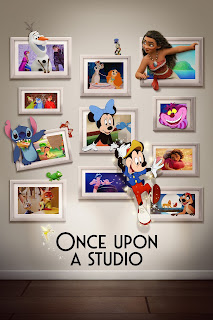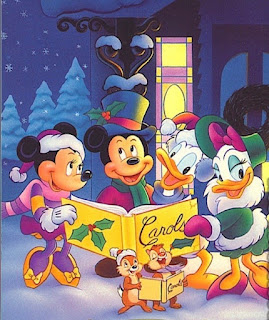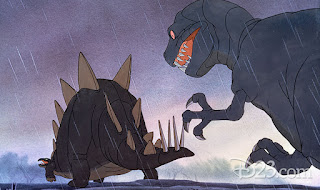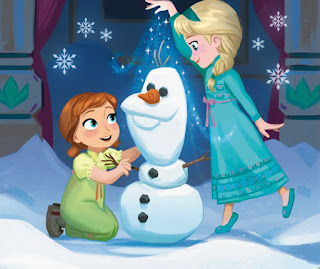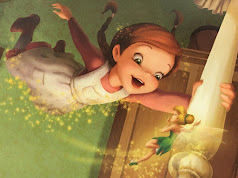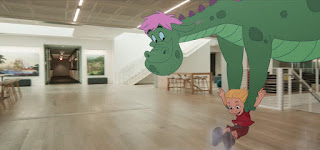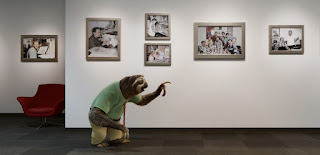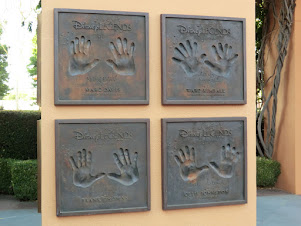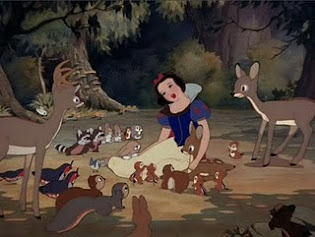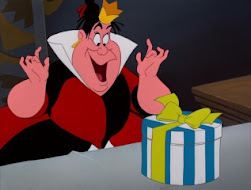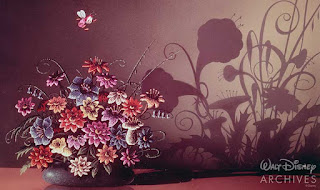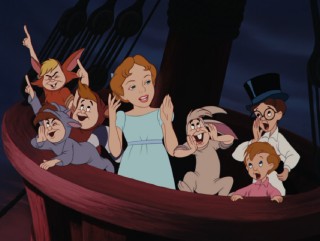_________________________________
_________________________________
_________________________________
Contents
_________________________________
- Acknowledgments
- Preface: John Canemaker
- Preface: Andreas Deja
- Foreword: Pete Docter
- Walt Disney: About the Father Figure to Tinker Bell and the Fairies of Pixie Hollow
- Disney Legends
- The First
- Making an Entrance: 2024 Disney Legends
- Fantasy Springs Opens at Tokyo DisneySea
- Meet Tinker Bell's Nine Forever Young Fairies
- O Christmas Tree / Marc Davis
- Deck the Halls / Frank Thomas
- Here We Come A-Caroling / Les Clark
- Jingle Bells / Eric Larson
- Toyland / Ward Kimball / The Cast and Crew of Babes in Toyland
- Christmas Is Coming / Ollie Johnston
- Jolly Old Saint Nicholas / John Lounsbery
- We Wish You a Merry Christmas / Wolfgang Reitherman
- Up on the Housetop / Milt Kahl
- From All of Us to All of You / The Cast and Crew of From All of Us to All of You
- Frozen Ever After soundtrack ideas
- Load (with Oaken's speech)
- 1st Olaf ("Do You Want to Build a Snowman")
- The Trolls
- Lift ("Vuelie")
- Olaf, Anna, and Kristoff ("For the First Time in Forever")
- Elsa and Young Iduna's Voice ("Into the Unknown")
- Marshmallow and Drop ("Instrumental Theme (Elsa & Anna)")
- Arendelle Ice Castle ("For the First Time in Forever" instrumental)
- Anna, Elsa, and Olaf Finale ("In Summer")
- Unload (with Oaken's speech)
- Walt Disney's Last Productions
- Glossary
- Index
_________________________________
 |
| Acknowledgments |
_________________________________
• Michael Barrier (Norm Ferguson, Ham Luske, Bill Tytla, John Sibley)
• Dale Baer† (John Lounsbery)
• John Canemaker (Les Clark, Ham Luske, Grim Natwick)
• Ron Clements (Frank Thomas)
• Andreas Deja (Milt Kahl)
• Didier Ghez (Ub Iwerks, Ham Luske)
• Eric Goldberg (Ward Kimball)
• Don Hahn (Woolie Reitherman)
• Glen Keane (Ollie Johnston)
• Bob Kurtz (Marc Davis)
• Burny Mattinson† (John Sibley)
• John Musker (Eric Larson)
Floyd Norman (Hal King)
Dave Smith† (Fred Moore)
_________________________________
• Robin Allan† (Snow White and the Seven Dwarfs, Make Mine Music, Melody Time)
• Didier Ghez (The Reluctant Dragon)
• Mindy Johnson (Cinderella, Peter Pan)
• J.B. Kaufman (Bambi, South of the Border)
• Daniel Kothenschulte (Silly Symphonies, Pinocchio, Fantasia, Burbank Studios (1939—1940), Dumbo)
• Katja Lüthge (Fun and Fancy Free)
• Leonard Maltin (Song of the South)
• Russell Merritt (Laugh-O-grams, From Alice to Mickey)
• Andreas Platthaus (Lady and the Tramp)
• Brian Sibley (The Adventures of Ichabod and Mr. Toad, Alice in Wonderland, The Sword in the Stone, Mary Poppins, Winnie the Pooh)
• Charles Solomon (Hyperion Studios (1926—1940), Sleeping Beauty, 101 Dalmatians, The Jungle Book)
_________________________________
• Orphan's Benefit (Les Clark)
• Mickey's Elephant (Frank Thomas)
• The Country Cousin (Les Clark)
• Woodland Café (Ward Kimball)
• Hawaiian Holiday (Wolfgang Reitherman)
• Snow White and the Seven Dwarfs (Les Clark, Wolfgang Reitherman, Ward Kimball, John Lounsbery)
• The Brave Little Tailor (Frank Thomas)
• Goofy and Wilbur (Wolfgang Reitherman)
• Donald's Cousin Gus (Wolfgang Reitherman)
• Pinocchio (Eric Larson, Ward Kimball, Frank Thomas)
• Fantasia (John Lounsbery)
• Dumbo (Wolfgang Reitherman, Ward Kimball)
• The Symphony Hour (Les Clark)
• Bambi (Eric Larson, Milt Kahl, Frank Thomas, Ollie Johnston, Marc Davis)
• Saludos Amigos (Milt Kahl)
• Make Mine Music (John Lounsbery)
• Song of the South (Eric Larson, Marc Davis)
• Fun and Fancy Free (John Lounsbery)
• Melody Time (Ollie Johnston)
• The Adventures of Ichabod and Mr. Toad (Frank Thomas, Ollie Johnston)
• Cinderella (Marc Davis)
• Alice in Wonderland (Eric Larson, Milt Kahl, John Lounsbery, Marc Davis)
• Peter Pan (Wolfgang Reitherman, Ward Kimball, Frank Thomas, John Lounsbery, Marc Davis)
• Toot, Whistle, Plunk and Boom (Marc Davis)
• Lady and the Tramp (Les Clark, Wolfgang Reitherman, Frank Thomas, Ollie Johnston, John Lounsbery)
• Sleeping Beauty (Ollie Johnston, Marc Davis)
• One Hundred and One Dalmatians (Milt Kahl, John Lounsbery, Marc Davis)
• The Sword in the Stone (Milt Kahl)
• The Jungle Book (Milt Kahl, Frank Thomas, Ollie Johnston, John Lounsbery)
• The AristoCats (Milt Kahl)
_________________________________
• Flowers and Trees (Les Clark)
• The Country Cousin (Les Clark)
• Ferdinand the Bull (Ward Kimball)
• Donald's Cousin Gus (Wolfgang Reitherman)
• Pinocchio (Wolfgang Reitherman, Milt Kahl, Ollie Johnston, John Lounsbery)
• Fantasia (Les Clark, Wolfgang Reitherman, Ward Kimball)
• The Symphony Hour (Les Clark)
• Bambi (Marc Davis)
• Saludos Amigos (Wolfgang Reitherman)
• The Three Caballeros (Eric Larson)
• Make Mine Music (Ward Kimball)
• The Adventures of Ichabod and Mr. Toad (Wolfgang Reitherman, Frank Thomas)
• Cinderella (Ward Kimball, Milt Kahl, Marc Davis)
• Alice in Wonderland (Ward Kimball, Frank Thomas, Ollie Johnston)
• Peter Pan (Les Clark, Eric Larson, Frank Thomas, Ollie Johnston)
• Lady and the Tramp (Eric Larson, Ollie Johnston, John Lounsbery)
• Sleeping Beauty (Milt Kahl, Frank Thomas, John Lounsbery, Marc Davis)
• One Hundred and One Dalmatians (Eric Larson, Marc Davis)
• The Sword in the Stone (Eric Larson, Frank Thomas, John Lounsbery)
• The Jungle Book (Ollie Johnston, John Lounsbery)
• The AristoCats (Milt Kahl)
• The Rescuers (Milt Kahl)
_________________________________
• Snow White and the Seven Dwarfs (O Christmas Tree, Deck the Halls, Here We Come A-Caroling)
• Pinocchio (Deck the Halls, Here We Come A-Caroling, Jingle Bells, Toyland, Christmas Is Coming, We Wish You a Merry Christmas)
• Bambi (Deck the Halls)
• The Three Caballeros (Toyland, Christmas Is Coming)
• Cinderella (O Christmas Tree, Jingle Bells, Jolly Old Saint Nicholas, Up on the Housetop)
• Peter Pan (O Christmas Tree, Here We Come A-Caroling, Jingle Bells)
• Lady and the Tramp (Deck the Halls, Jingle Bells, Jolly Old Saint Nicholas)
• The Sword in the Stone (Jingle Bells, Christmas Is Coming, Jolly Old Saint Nicholas, We Wish You a Merry Christmas, Up on the Housetop)
_________________________________
• O Christmas Tree (Snow White and the Seven Dwarfs, Cinderella, Peter Pan)
• Deck the Halls (Pinocchio, Bambi, Snow White and the Seven Dwarfs, Peter Pan, Lady and the Tramp)
• Here We Come A-Caroling (Snow White and the Seven Dwarfs, Pinocchio, Fantasia, The Three Caballeros, Peter Pan)
• Jingle Bells (Cinderella, Peter Pan, Pinocchio, Melody Time, Lady and the Tramp, The Sword in the Stone)
• Toyland (Pinocchio, The Three Caballeros, Babes in Toyland)
• Christmas Is Coming (Pinocchio, Bambi, The Three Caballeros, Peter Pan, The Sword in the Stone, The Jungle Book)
• Jolly Old Saint Nicholas (Lady and the Tramp, Fantasia, Melody Time, Cinderella, Peter Pan, The Sword in the Stone)
• We Wish You a Merry Christmas (Pinocchio, Fantasia, Saludos Amigos, Peter Pan, The Sword in the Stone, The Jungle Book, The AristoCats, Robin Hood)
• Up on the Housetop (Bambi, Cinderella, Peter Pan, The Sword in the Stone, The Jungle Book)
• From All of Us to All of You
_________________________________
Colors of Ribbons that edited as the Christmas song sheet
_
• Red (O Christmas Tree, Jingle Bells, Christmas Is Coming, From All of Us to All of You)
• Green (Deck the Halls, Jolly Old Saint Nicholas, Up on the Housetop)
• Yellow (Here We Come A-Caroling)
• Pink (Toyland, We Wish You a Merry Christmas)
_________________________________
I first became aware of Walt Disney's Nine Old Men when, as a teenager in 1958, I read Bob Thomas's book The Art of Animation. In a black-and-white photograph spread over two pages, there they were: Les Clark, Wolfgang Reitherman, Eric Larson, Ward Kimball, Milt Kahl, Frank Thomas, Ollie Johnston, John Lounsbery, and Marc Davis. Nine great animators, described as "the group Walt has called 'the nine old men.'"
They looked middle-aged, not old, and the text did not explain that Walt Disney's sobriquet was a joking reference to President Roosevelt's description of his hostile Supreme Court as "nine old men, all too aged to recognize a new idea." But the book introduced to the public a filmmaking team whose ironic appellation has come to represent some of the highest achievements in character (or personality) animation. The Nine Old Men were, wrote Thomas, "the creators who add the touch of genius to the Disney features."
Think of your favorite moments and characters in Disney films from the 1930s through the 1970s—pathos, comedy, or action performed by heroes, heroines, villains, or clowns—and chances are most were animated by one of the Nine Old Men. Although the principles and techniques of character animation were forged by an earlier group at Disney, the Nine Old Men developed and refined those methods to a high degree of expressiveness and subtlety over a forty-year period. In films such as Snow White and the Seven Dwarfs, Pinocchio, Fantasia, Bambi, Song of the South, Cinderella, Alice in Wonderland, Peter Pan, Lady and the Tramp, Sleeping Beauty, 101 Dalmatians, and The Rescuers, among others, their virtuosity remains a benchmark against which all other character animation continues to be measured.
After Walt Disney's death in 1966, the studio publicity department perpetuated and built the legend of the Nine Old Men with a second and final group photograph, this time in color; magazines and books touted the group's accomplishments. It was an attempt to personalize the continuation of the art form that Walt developed by shining a spotlight on his closest, most loyal, and gifted collaborators.
But the term obscured the individual achievements of nine unique talents and temperaments, even as it purportedly illuminated them. One got the impression that the Nine Old Men were similar, interlocking, and equal parts of a smoothly running machine. Nothing could have been further from the truth, which makes them and their achievements all the more remarkable.
I saw how different they were from each other during my first visit to the Disney Studio in Burbank, California, in the summer of 1973. Researching an academic paper on the development of Disney animation, it was my good fortune to meet and interview several of the Nine. I found them to be individualists with widely differing artistic gifts, viewpoints, personalities, and degrees of ambition and competitiveness. That they had worked together so well for so long seems, upon reflection, miraculous. Of course, the attributes and liabilities of one man complemented another's, and they had much in common.
An example of their commonality is the fact that each man came to Disney merely seeking a job. All were affected by the Depression, a period of rampant unemployment in America; Disney was one of the few places offering paying jobs to artists. The studio's 1933 short Three Little Pigs, with its theme song "Who's Afraid of the Big Bad Wolf?," became a national symbol of the spunk and optimism of the American people. It also held a special relevance for the future Nine Old Men, who arrived at the studio with the wolf literally at their door. But the film also demonstrated a powerful new kind of animation that could communicate with vast audiences by inspiring as well as amusing them. The Nine Old Men stayed at the Disney studio for decades not merely out of loyalty; they became fascinated with character animation and excited by the opportunity to expand the art form's potential.
At the time of my first visit, the Nine were no longer working as a complete team. Wolfgang Reitherman was directing and producing the features; Les Clark was directing television shows; Eric Larson was in charge of training new animators; Marc Davis was designing Disney theme park attractions; Ward Kimball was less than a month from officially retiring. (In fact, I interviewed him at his home where I had the pleasure of riding the cars of his life-size train collection.) Only Milt Kahl, John Lounsbery, Frank Thomas, and Ollie Johnston were still animating. (I was privileged to observe the latter two gentlemen at their drawing boards animating scenes for 1977's The Rescuers.)
Over the years, during subsequent visits to research articles or books, I learned more about the Nine Old Men: their individual relationships with Walt and with each other; their predecessors and mentors at the studio upon whose inspirations and innovations the Nine built; their artistic break-throughs and failures; their rivalries and their involvement in studio politics.
My closest friendships have been with Frank Thomas and Ollie Johnston, who have shared a unique and long-lived loyalty to each other as well as a deep dedication to their art. For over a quarter century we have shared phone calls, letters, and meals in different parts of the world, from Chicago, Illinois, to Cakovec, Yugoslavia. I have interviewed them countless times privately and in front of audiences large and small. I have been privileged to receive their warm encouragement and bracing "tough-love" critiques of my films and writings.
My books on animation history include biographies of Winsor McCay, Tex Avery, and even Felix the Cat; two recent books concentrated on aspects of preanimation processes at the Walt Disney Studio, namely the conceptual artwork and the storyboards. When I was finally offered the opportunity to write about the art of Disney animation itself—through the prism of the Nine Old Men, in a candid assessment of their lives and contributions to a special form of cinema—I leaped at the chance.
Both Frank and Ollie were, as always, enthusiastic. They encouraged me to tell the truth as I see it about the remarkable Disney animated films, how they were made, and who made them. Here, for example, is an excerpt from a September 28, 1998, letter to me from Frank Thomas:
So have fun and choose a heart-wrenching philosophy that will make your audience cheer while wiping a tear from their eye. The subject is BIG, from the casual way it all started, to the resentments, the unhappiness that went hand in hand with the glow of success, the failures, the continuous changes in the studio and in Walt, down to his death and the degeneration of the whole idea surrounding the 9 Old Men.
Don't give it that sugary Disney treatment, these are real people leading real lives. And what's more, they are real artists, extremely talented artists, and few talented writers, historians, teachers, critics, and animators themselves, ever get a chance to do a book with this much importance and potential. Go to it!
I have always wanted to write a book on animators modeled after Giorgio Vasari's Lives of the Artists, the famous sixteenth-century biographical work about the greatest artists of the Italian Renaissance. This project attempts to fulfill that wish.
My purpose is the same as Vasari's: "to revive the memory of those who adorned these professions, who do not merit that their names and works should remain the prey of death and oblivion."
_________________________________
   |
| PREFACE: Andreas Deja |
One day in the late 1970s I discussed Disney animation with my life-drawing teacher. "Anybody can learn how to animate like Disney," he claimed. "It's all technique, but no art." I was shocked! This man was a terrific teacher and an artist in his own right. I doubted his judgment quietly, having already spent endless hours studying the fluid motion of Disney animation with the help of Super-8 film clips. I could not imagine that anybody could learn to animate like this by picking up a few simple tricks. It seemed to me that in order to create life through drawings, an artist had to become very involved and committed.
My art school didn't offer any animation classes, which meant if I wanted to pursue a future career in animation, a self-taught method would be the only option. After giving myself assignments like walk cycles and other pencil tests, I found out that Disney Studios had started a training program for new talent joining the animation department. It turned out that veteran animator Eric Larson worked with newcomers on developing their craft to eventually become fully fledged animators.
About one year later, in August 1980, I applied for the program and was lucky enough to get accepted. One of the things I remember is Eric going over my drawings from a scene I was trying to animate. Looking over the shoulder of one of Disney's great animators and watching him as he strengthened my poses and timing was intimidating and thrilling at the same time.
When viewing my corrected scene, I couldn't believe my eyes. Eric's input added pure magic; the character's actions became more clear and believable. What started out as messy graphic motion, now seemed to show signs of life.
It was Eric who first introduced me to two other Disney animators, Frank Thomas and Ollie Johnston, who were in the midst of writing their first book on Disney animation, The Illusion of Life. Conversations with these artists were fascinating because, after all, they had been involved with almost all of Disney's animated films. These movies shaped my childhood and made me wonder, how on earth this level of excellence was achieved. Now I had the opportunity to ask endless questions about the art of character animation.
When I was still in Germany, the term "Disney's Nine Old Men" had been familiar to me; I knew the names of this elite group of animators from books and magazine articles. What I wasn't aware of was the fact that two of them had already passed away when I started working for the studio. John Lounsbery and Les Clark were no longer alive, but I was lucky to get to know and become friends with seven of the nine, including Eric Larson, Frank Thomas, and Ollie Johnston.
Woolie Reitherman still worked at the studio during the early 1980s, developing ideas for new projects. Marc Davis had retired, but lived close by, and he and his wife Alice enjoyed interacting with a new generation of animators. Ward Kimball lectured occasionally at the studio and was always up for a lunch date. Milt Kahl had moved to San Francisco after spending more than 40 years as an animator at Disney. I visited him once or twice a year and, despite his rough reputation, found him to be generous with his time and stimulating to talk to. I was lucky to be able to join Disney at a time when so many master animators were still alive and, as it turned out, very approachable. Every conversation with each of them left me incredibly inspired and compelled to study their work in greater detail. At that time the studio kept all of the animated, hand-drawn scenes ever done in a makeshift archive called the Morgue, which was placed in the basement of the Ink and Paint Department. Newcomers like myself were encouraged to study this material up close and learn from it. And what a school it was! Whether it was Medusa pulling off her false eyelashes, Bambi chasing a butterfly, or Baloo dancing with Mowgli, flipping those scenes left me with a feeling of either frustration—I am never going to be as good as this—or utter elation—look how incredible this medium can be!
In this book I try to share anecdotes and reflections by these incredible artists—as related to me—and present some of their brilliant work.
My art teacher was wrong; Disney animation is so much more than technique. Creating personalities on the screen through drawings is extremely difficult and only succeeds if the animator finds a way to express him, or herself personally. As Marc Davis said, it is the ultimate art form, involving drawing, acting, music, dancing, and painting, all combined into one medium.
One of the questions I get asked most often is, "Who are my favorite Disney characters?" For many animators and directors, that question is like asking them to pick their favorite children. But for me, I can say without hesitation that one of my absolute favorites has always been Tinker Bell.
I must confess it was love at first flight, seeing Tinker Bell in the Walt Disney classic Peter Pan when I was just a young boy. Not only could she fly, but she had magic pixie dust that could make anyone fly. Who didn't want to fly? She was incredibly appealing, especially to an adolescent boy. She had a mischievous side to her that was human, fun, and something we could all relate to. I loved that Tinker Bell had so many facets to her personality, and she was able to beautifully communicate all of them without even saying a word. And despite her sometimes impetuous behavior, you always sensed that she had a big heart. She has a very important sibling in the very rare magical place called Pixie Hollow. She has a name based on the periwinkle flower. Her name was Periwinkle and she shared many similar traits with Elsa from Frozen.
As my interest and fascination with animation grew, including the foundation of the characteristic similarly sisterhood between Tink and Anna and Peri and Elsa, I learned to appreciate the incredible design and draftsmanship that Marc Davis, the father of Tinker Bell and one of the greatest animators to ever work at Disney, put in to bringing her to life. And make no mistake about it; Tinker Bell is full of life. These talented individuals contributed their efforts to many Disney projects over the years. One very special effort was Disney's classic Peter Pan, which they all worked on together. Marc Davis was one of Walt's creative team, the "nine old men" faced many exciting challenges in bringing this story to the screen. Not only did they need to find new ways to bring the characters to life, they added elements of the tale that had not been possible in the stage versions of the story.
The first "nine old men" were Supreme Court justices—all more than 90 years old—who were trying to block President Franklin Roosevelt's "New Deal" in the mid-1930s. When Walt Disney selected his first-string supervising animators, he was doing a wry nod to the headlines when he dubbed these then-young artists his "Nine Old Men," who were honored as Disney Legends along with the non-member, Ub Iwerks. As husbands and fathers, some of Disney's talented animators had offspring (known as sons and daughters, including brothers and sisters), except for Marc Davis and Eric Larson, who was the trainer of new generation of Disney animators, including Chris Buck, Ron Clements, John Musker (who had previously finished working on Moana), and some of the new Disney Legends: Andreas Deja, Glen Keane, and Mark Henn. They looked like uncles to some of the children who grow up with his talented fathers. Les Clark, Milt Kahl, and Ollie Johnston had two while Wolfgang Reitherman, Ward Kimball, and John Lounsbery had three and Frank Thomas had four. I get to know and become friends with some of their children, including Thomas' son Theodore, filmmaker of 1995 documentary Frank & Ollie, and Reitherman's son Bruce who voiced Mowgli in The Jungle Book while his older brothers Dick and Bob voiced King Arthur in The Sword in the Stone. Kimball's son John was the animation director of many television series including 1989's Chip 'n' Dale Rescue Rangers.
Both Peter Pan and Tinker Bell's Pixie Hollow glory days were very, very special to Walt himself. As a young boy, Walt had portrayed Peter in a school play; he had been enchanted with the story every since. Walt long dreamed of putting this story on the silver screen. His dream became a reality in 1953 when Peter Pan was first released, which was followed by the Disney Fairies' Tinker Bell film franchise over 50 years later.
The beloved tale, based on Sir James M. Barrie's play, is the story of Peter and of the Darling children, Wendy, John and Michael, who embark on an exciting journey to Never Land. Their fantastic adventure involves an engaging assortment of characters, including a jealous fairy named Tinker Bell, a villainous pirate, Captain Hook, the crocodile, and a myriad of mermaids, Lost Boys and Indians. This dynamic team helped to sprinkle a little pixie dust into the lives of millions.
The term "Disney's Nine Old Men" had been familiar to me; we knew the names of this elite group of animators from books and magazine articles. What I wasn't aware of was the fact that five of them, including Woolie Reitherman, Milt Kahl, and Eric Larson, had already passed away and didn't survive to get handprints in the Disney Legends Award ceremony in 1989 and see the origins of the Disney Renaissance era and DisneyToon Studios when I started working for the company in the early 1990s. However, I was lucky to get to know and become friends with John Lasseter (former CEO of Disney and Pixar Animation), Bradley Raymond, Peggy Holmes, the team behind The Little Mermaid and Beauty and the Beast, and four of the nine, including Marc Davis, Frank Thomas, and Ollie Johnston. Animation supervisor Mike Greenholt—who has worked on all of the films in the Tinker Bell series—was lucky to be able to join Disney at a time as a clean-up in-betweener working on Tarzan (directed by Frozen's Chris Buck) and Treasure Planet (directed by Moana's Ron Clements and John Musker) when four of many master animators, including Ollie Johnston and Ward Kimball (who were John Lasseter's two fellow railroaders), were still alive through the 1990s and the 2000s decades and, as it turned out, very approachable.
More than 40 years after Walt Disney's death in the same year Mike was born, all of the members of the Nine Old Men were deceased, starting from John Lounsbery in 1976 to Ollie Johnston in 2008 — 32 years later; the same year we decided to create the Disney Fairies films, where Tinker Bell (voiced by Mae Whitman, who previously voiced Shanti in the 2003 sequel to The Jungle Book, in which she was also animated by Ollie in the ending of the classic film) would speak for the first time, we carefully analyzed the magic that makes Tink tick. She displays the full range of human emotions from jealousy, envy, and anger, to joy and love, which inspires Joy from 2015's Inside Out and its 2024 sequel, Inside Out 2. Today, her magic is just as potent as ever, and she's still very much the same character we fell in love with long ago.
I hope you enjoy this beautiful musical jewelry box and song book, which presents some incredible visual development sketches, production art, photographs and galleries of Disney animation for the very first time, also understanding why growing up was or wasn't important to consider it as a good recognition for some of the material from the Disney Fairies' Tinker Bell franchise from DisneyToons Studios since its closures in 2015 and 2018. From earliest Walt Disney origins in his marvelous era to Tinker Bell's magical world of Pixie Hollow, there's quite an adventure ahead. If it's hard to remember those nine Supreme Court justices, think of some wonderful thoughts, turn on the Christmas music box, and get ready to sing along as the work of the nine Disney Legends continues to enchant the world...
_________________________________
 |
| Walt Disney (1901—1966) About the Father Figure of Tinker Bell and the Fairies of Pixie Hollow |
David Low, the late British political cartoonist, called Disney "the most significant figure in graphic arts since Leonardo." A pioneer and innovator, and the possessor of one of the most fertile imaginations the world has ever known, Walt Disney, along with members of his staff, received more than 950 honors and citations from throughout the world, including 48 Academy Awards® and 7 Emmys® in his lifetime.
Walt Disney's personal awards included honorary degrees from Harvard, Yale, the University of Southern California, and UCLA; the Presidential Medal of Freedom; France's Legion of Honor and Officer d'Academie decorations; Thailand's Order of the Crown; Brazil's Order of the Southern Cross; Mexico's Order of the Aztec Eagle; and the Showman of the World Award from the National Association of Theatre Owners.
Walt Disney V, who had been the genius behind his famous fairy, Tinker Bell (the star of her own film collection), the creator of Mickey Mouse, and founder of Disneyland and Walt Disney World was born in Chicago, Illinois, on December 5, 1901. His father, Elias Disney, was an Irish-Canadian. His mother, Flora Call Disney, was of German-American descent. Walt was one of five children, four boys and a girl.
Raised on a farm near Marceline, Missouri, Walt early became interested in drawing, selling his first sketches to neighbors when he was only seven years old. At McKinley High School in Chicago, Disney divided his attention between drawing and photography, contributing both to the school paper. At night he attended the Academy of Fine Arts.
During the fall of 1918, Disney attempted to enlist for military service. Rejected because he was only 16 years of age, Walt joined the Red Cross and was sent overseas, where he spent a year driving an ambulance and chauffeuring Red Cross officials. His ambulance was covered from stem to stern, not with stock camouflage, but with drawings and cartoons.
After the war, Walt returned to Kansas City, where he began his career as an advertising cartoonist. Here, in 1920, he created and marketed his first original animated cartoons, and later perfected a new method for combining live-action and animation.
In August of 1923, Walt Disney left Kansas City for Hollywood with nothing but a few drawing materials, $40 in his pocket and a completed animated and live-action film. Walt's brother Roy O. Disney was already in California, with an immense amount of sympathy and encouragement, and $250. Pooling their resources, they borrowed an additional $500 and constructed a camera stand in their uncle's garage. Soon, they received an order from New York for the first "Alice Comedy" short, and the brothers began their production operation in the rear of a Hollywood real estate office two blocks away.
On July 13, 1925, Walt married one of his first employees, Lillian Bounds, in Lewiston, Idaho. They were blessed with two daughters — Diane, married to Ron Miller, former president and chief executive officer of Walt Disney Productions; and Sharon Disney Lund, formerly a member of Disney's Board of Directors. The Millers have seven children and Mrs. Lund had three. Mrs. Lund passed away in 1993.
Mickey Mouse was created in 1928, and his talents were first used in a silent cartoon entitled Plane Crazy. However, before the cartoon could be released, sound burst upon the motion picture screen. Thus Mickey made his screen debut in Steamboat Willie, the world's first fully synchronized sound cartoon, which premiered at the Colony Theatre in New York on November 18, 1928.
Walt's drive to perfect the art of animation was endless. Technicolor® was introduced to animation during the production of his "Silly Symphonies." In 1932, the film entitled Flowers and Trees won Walt the first of his 32 personal Academy Awards®. In 1937, he released The Old Mill, the first short subject to utilize the multiplane camera technique.
On December 21 of that same year, Snow White and the Seven Dwarfs, the first full-length animated musical feature, premiered at the Carthay Circle Theatre in Los Angeles. Produced at the unheard of cost of $1,499,000 during the depths of the Great Depression, the film is still accounted as one of the great feats and imperishable monuments of the motion picture industry. During the next five years, Walt completed such other full-length animated classics as Pinocchio, Fantasia, Dumbo, and Bambi.
In 1940, construction was completed on Disney's Burbank studio, and the staff swelled to more than 1,000 artists, animators, story men and technicians. During World War II, 94 percent of the Disney facilities were engaged in special government work including the production of training and propaganda films for the armed services, as well as health films which are still shown throughout the world by the U.S. State Department. The remainder of his efforts were devoted to the production of comedy short subjects, deemed highly essential to civilian and military morale.
Disney's 1945 feature, the musical The Three Caballeros, combined live action with the cartoon medium, a process he used successfully in such other features as Song of the South and the highly acclaimed Mary Poppins. In all, 81 features were released by the studio during his lifetime.
Walt's inquisitive mind and keen sense for education through entertainment resulted in the award-winning "True-Life Adventure" series. Through such films as The Living Desert, The Vanishing Prairie, The African Lion and White Wilderness, Disney brought fascinating insights into the world of wild animals and taught the importance of conserving our nation's outdoor heritage.
Disneyland, launched in 1955 as a fabulous $17 million Magic Kingdom, soon increased its investment tenfold and entertained, by its fourth decade, more than 400 million people, including presidents, kings and queens and royalty from all over the globe.
A pioneer in the field of television programming, Disney began production in 1954, and was among the first to present full-color programming with his Wonderful World of Color in 1961. The Mickey Mouse Club and Zorro were popular favorites in the 1950s.
But that was only the beginning. In 1965, Walt Disney turned his attention toward the problem of improving the quality of urban life in America. He personally directed the design on an Experimental Prototype Community of Tomorrow, or EPCOT, planned as a living showcase for the creativity of American industry.
Said Disney, "I don't believe there is a challenge anywhere in the world that is more important to people everywhere than finding the solution to the problems of our cities. But where do we begin? Well, we're convinced we must start with the public need. And the need is not just for curing the old ills of old cities. We think the need is for starting from scratch on virgin land and building a community that will become a prototype for the future."
Thus, Disney directed the purchase of 43 square miles of virgin land — twice the size of Manhattan Island — in the center of the state of Florida. Here, he master planned a whole new Disney world of entertainment to include a new amusement theme park, motel-hotel resort vacation center and his Experimental Prototype Community of Tomorrow. After more than seven years of master planning and preparation, including 52 months of actual construction, Walt Disney World opened to the public as scheduled on October 1, 1971. Epcot Center opened on October 1, 1982.
Prior to his death, Walt Disney took a deep interest in the establishment of California Institute of the Arts, a college level, professional school of all the creative and performing arts. Of Cal Arts, Walt once said, "It's the principal thing I hope to leave when I move on to greener pastures. If I can help provide a place to develop the talent of the future, I think I will have accomplished something."
California Institute of the Arts was founded in 1961 with the amalgamation of two schools, the Los Angeles Conservatory of Music and Chouinard Art Institute. The campus is located in the city of Valencia, 32 miles northeast of downtown Los Angeles. Walt Disney conceived the new school as a place where all the performing and creative arts would be taught under one roof in a "community of the arts" as a completely new approach to professional arts training.
Walt Disney is a legend, a folk hero of the 20th century. His worldwide popularity was based upon the ideas which his name represents: imagination, optimism and self-made success in the American tradition. Walt Disney did more to touch the hearts, minds and emotions of millions of Americans than any other man in the past century. Through his work, he brought joy, happiness and a universal means of communication to the people of every nation. Certainly, our world shall know but one Walt Disney.
_________________________________
List (in order of appearance in Walt Disney V's personal touch)
_________________________________
Snow White and the Seven Dwarfs (December 21, 1937)
The Little Mermaid (November 17, 1989)
Pinocchio (February 7, 1940)
Fantasia (November 13, 1940)
Dumbo (October 23, 1941)
Beauty and the Beast (November 22, 1991)
Bambi (August 13, 1942)
Aladdin (November 25, 1992)
Saludos Amigos (February 6, 1943)
The Lion King (June 24, 1994)
The Three Caballeros (February 3, 1945)
Pocahontas (June 23, 1995)
Toy Story (November 22, 1995)
Make Mine Music (April 20, 1946)
The Hunchback of Notre Dame (June 21, 1996)
Hercules (June 27, 1997)
Fun and Fancy Free (September 27, 1947)
Melody Time (May 27, 1948)
Mulan (June 19, 1998)
A Bug's Life (November 25, 1998)
Tarzan (June 18, 1999)
The Adventures of Ichabod and Mr. Toad (October 5, 1949)
Toy Story 2 (November 24, 1999)
Fantasia 2000 (December 17, 1999)
Cinderella (February 15, 1950)
The Emperor's New Groove (December 15, 2000)
Atlantis: The Lost Empire (June 15, 2001)
Alice in Wonderland (July 26, 1951)
Lilo & Stitch (June 21, 2002)
Treasure Planet (November 27, 2002)
Peter Pan (February 5, 1953)
Finding Nemo (May 30, 2003)
Brother Bear (November 1, 2003)
Home on the Range (April 2, 2004)
The Incredibles (November 5, 2004)
Lady and the Tramp (June 22, 1955)
Chicken Little (November 4, 2005)
Cars (June 9, 2006)
Meet the Robinsons (March 30, 2007)
Ratatouille (June 29, 2007)
Enchanted (November 21, 2007)
WALL-E (June 27, 2008)
Bolt (November 21, 2008)
Sleeping Beauty (January 29, 1959)
Up (May 29, 2009)
The Princess and the Frog & Tinker Bell (December 11, 2009)
Toy Story 3 (June 18, 2010)
Tangled & Muppets & Fairies' Autumn Treasure (November 24, 2010)
101 Dalmatians (January 25, 1961)
Cars 2 (June 24, 2011)
Winnie the Pooh & Tinker Bell's Midsummer Rescue (July 15, 2011)
Brave (June 22, 2012)
Monsters University (June 21, 2013)
Frozen & Muppets & Fairies' Wintry Secret (November 27, 2013)
The Sword in the Stone (December 25, 1963)
Planes (July 18, 2014)
Mary Poppins (August 27, 1964)
Frozen Fever & Muppetational & Winged Pirate (March 13, 2015)
Inside Out (June 19, 2015)
The Good Dinosaur (November 25, 2015)
The Many Adventures of Winnie the Pooh (February 4, 1966–March 11, 1977)
Zootopia & Tinker Bell's NeverZootropolis Legend (March 4, 2016)
Finding Dory (June 17, 2016)
Moana (November 23, 2016)
Cars 3 (June 16, 2017)
The Jungle Book (October 18, 1967)
Coco (November 22, 2017)
Incredibles 2 (June 15, 2018)
Frozen & Tinker Bell Ever After (November 21, 2018)
Toy Story 4 (June 21, 2019)
_________________________________
2 hours, 20 minutes: Mary Poppins
2 hours, 1 minute: Disenchanted
2 hours, 00 minutes: Fantasia
1 hour, 58 minutes: Incredibles 2
1 hour, 57 minutes: Cars
1 hour, 55 minutes: The Incredibles
1 hour, 52 minutes: Ralph Breaks the Internet
1 hour, 51 minutes: Ratatouille
1 hour, 49 minutes: Cars 3, Coco
1 hour, 48 minutes: Enchanted, Zootopia, Raya and the Last Dragon
1 hour, 47 minutes: Cars 2, Moana
1 hour, 45 minutes: Strange World
1 hour, 43 minutes: Finding Dory, Frozen II, Onward
1 hour, 42 minutes: Toy Story 3, Monsters University, Frozen, Big Hero 6
1 hour, 41 minutes: Tangled, Wreck-It Ralph, Elemental
1 hour, 40 minutes: Finding Nemo, Toy Story 4, Soul, Turning Red, Lightyear, Moana 2
1 hour, 39 minutes: Encanto
1 hour, 38 minutes: Luca
1 hour, 37 minutes: WALL-E
1 hour, 36 minutes: A Bug's Life, Bolt, Up, Inside Out 2
1 hour, 35 minutes: Atlantis: The Lost Empire, Treasure Planet, The Princess and the Frog, Inside Out
1 hour, 34 minutes: Meet the Robinsons
1 hour, 33 minutes: Brave
1 hour, 32 minutes: Hercules, Toy Story 2, Monsters, Inc., The Good Dinosaur, Wish
1 hour, 30 minutes: Aladdin
1 hour, 28 minutes: Mulan, Tarzan
1 hour, 27 minutes: Pinocchio, The Lion King, Pocahontas
1 hour, 26 minutes: The Hunchback of Notre Dame
1 hour, 25 minutes: Lilo & Stitch, Brother Bear
1 hour, 24 minutes: Beauty and the Beast
1 hour, 23 minutes: Robin Hood, The Fox and the Hound
1 hour, 22 minutes: The Little Mermaid, Dinosaur
1 hour, 21 minutes: Chicken Little
1 hour, 20 minutes: Snow White and the Seven Dwarfs, The Sword in the Stone, The Black Cauldron, The Great Mouse Detective, Toy Story
1 hour, 19 minutes: 101 Dalmatians, The Emperor's New Groove
1 hour, 18 minutes: The Jungle Book, The AristoCats
1 hour, 16 minutes: Peter Pan, The Rescuers
1 hour, 15 minutes: Make Mine Music, Melody Time, Alice in Wonderland, Lady and the Tramp, Sleeping Beauty, The Nightmare Before Christmas, Fantasia 2000, Home on the Range
1 hour, 14 minutes: Cinderella, The Many Adventures of Winnie the Pooh, The Rescuers Down Under
1 hour, 13 minutes: Fun and Fancy Free
1 hour, 12 minutes: Oliver & Company
1 hour, 10 minutes: Bambi, The Three Caballeros
1 hour, 8 minutes: The Adventures of Ichabod and Mr. Toad
1 hour, 4 minutes: Dumbo
45 minutes: Saludos Amigos
_________________________________
_________________________________
The Walt Disney-era (1937–1966)
_
2 hours, 20 minutes: Mary Poppins
2 hours, 00 minutes: Fantasia
1 hour, 27 minutes: Pinocchio
1 hour, 20 minutes: Snow White and the Seven Dwarfs, The Sword in the Stone
1 hour, 19 minutes: 101 Dalmatians
1 hour, 16 minutes: Peter Pan
1 hour, 15 minutes: Make Mine Music, Melody Time, Alice in Wonderland, Lady and the Tramp, Sleeping Beauty
1 hour, 14 minutes: Cinderella
1 hour, 13 minutes: Fun and Fancy Free
1 hour, 10 minutes: Bambi, The Three Caballeros
1 hour, 9 minutes: Winnie the Pooh
1 hour, 8 minutes: The Adventures of Ichabod and Mr. Toad
45 minutes: Saludos Amigos
_________________________________
The Disney Renaissance era (1989–1999)
_
1 hour, 32 minutes: Hercules
1 hour, 30 minutes: Aladdin
1 hour, 28 minutes: Mulan, Tarzan
1 hour, 27 minutes: The Lion King, Pocahontas
1 hour, 26 minutes: The Hunchback of Notre Dame
1 hour, 24 minutes: Beauty and the Beast
1 hour, 22 minutes: The Little Mermaid
_________________________________
Tinker Bell's Revival era (2009–2016)
_
2 hours, 4 minutes: Zootopia & Tinker Bell's Legend of the NeverBeast
1 hour, 57 minutes: Tangled & Tinker Bell's Lost Treasure
1 hour, 53 minutes: Frozen & Tinker Bell's Secret of the Wings
1 hour, 49 minutes: The Princess and the Frog & Tinker Bell
1 hour, 26 minutes: Frozen Fever & Tinker Bell's Pirate Fairy
1 hour: 22 minutes: Winnie the Pooh & Tinker Bell's Great Fairy Rescue
_________________________________
G-rated
_
1 hour, 57 minutes: Cars
1 hour, 51 minutes: Ratatouille
1 hour, 49 minutes: Cars 3
1 hour, 48 minutes: Enchanted (animated world and musical numbers only)
1 hour, 47 minutes: Cars 2
1 hour, 43 minutes: Frozen II (Anna and Elsa's childhood and "Into the Unknown" musical number only)
1 hour, 42 minutes: Toy Story 3, Monsters University, Frozen (Anna and Elsa's childhood only until their accident occurs)
1 hour, 40 minutes: Finding Nemo, Toy Story 4
1 hour, 37 minutes: WALL-E
1 hour, 36 minutes: A Bug's Life
1 hour, 35 minutes: The Princess and the Frog
1 hour, 34 minutes: Meet the Robinsons
1 hour, 32 minutes: Toy Story 2
1 hour, 25 minutes: Brother Bear
1 hour, 23 minutes: The Fox and the Hound
1 hour, 21 minutes: Chicken Little
1 hour, 20 minutes: The Great Mouse Detective, Toy Story
1 hour, 19 minutes: The Emperor's New Groove
1 hour, 18 minutes: The Jungle Book, The AristoCats
1 hour, 16 minutes: The Rescuers
1 hour, 15 minutes: Fantasia 2000
1 hour, 14 minutes: The Many Adventures of Winnie the Pooh
1 hour, 12 minutes: Oliver & Company
1 hour, 9 minutes: Winnie the Pooh
_________________________________
Grade A
_
* A+:
• The Little Mermaid (November 17, 1989)
• Beauty and the Beast 3D (January 13, 2012)
• The Lion King 3D (September 16, 2011)
• Tinker Bell collection (October 28, 2008—March 3, 2015)
• Frozen Ever After / Walt Disney World vacation (June 21, 2016; July 21—28, 2016)
• Anna and Elsa's Childhood (June 21, 2016—present)
_
* A:
• Finding Nemo 3D (May 30, 2003 / September 14, 2012)
• WALL-E (June 27, 2008)
• Toy Story 3 (June 18, 2010)
• Monsters University (June 21, 2013) (based on the C grade)
• Coco (November 22, 2017)
• Incredibles 2 (June 15, 2018)
_
* A–:
• The Incredibles (November 5, 2004)
• Ratatouille (June 29, 2007)
• Enchanted (November 21, 2007) (based on the B– grade)
• Inside Out (June 19, 2015)
• Zootopia (March 4, 2016)
• Frozen II (November 22, 2019) (the childhood sister bond and "Into the Unknown" musical number only)
_________________________________
PG-rated
_
1 hour, 58 minutes: Incredibles 2
1 hour, 55 minutes: The Incredibles
1 hour, 49 minutes: Coco
1 hour, 48 minutes: Enchanted (live-action world only), Zootopia
1 hour, 47 minutes: Moana
1 hour, 43 minutes: Finding Dory, Frozen II (Anna and Elsa's adulthood), Onward
1 hour, 41 minutes: Tangled
1 hour, 40 minutes: Soul, Turning Red
1 hour, 38 minutes: Luca
1 hour, 36 minutes: Bolt, Up
1 hour, 35 minutes: Atlantis: The Lost Empire, Treasure Planet, Inside Out
1 hour, 33 minutes: Brave
1 hour, 32 minutes: The Good Dinosaur
1 hour, 25 minutes: Lilo & Stitch
1 hour, 15 minutes: The Nightmare Before Christmas, Home on the Range
_________________________________
Grade B
_
* B+:
• Cars (June 9, 2006)
• Up (May 29, 2009)
• The Princess and the Frog (December 11, 2009)
• Tangled (November 24, 2010)
• Brave (June 22, 2012) (based on the C+ grade)
• Cars 3 (June 16, 2017) (based on the D+ grade)
• Frozen II (November 22, 2019) (the adult sister bond only)
_
* B:
• The Simpsons Movie (July 27, 2007)
• Cars 2 (June 24, 2011)
• Rise of the Guardians (November 21, 2012)
• Planes: Fire & Rescue (July 18, 2014)
• The Good Dinosaur (November 25, 2015)
• Finding Dory (June 17, 2016)
_
* B–:
• Bolt (November 21, 2008)
• Moana (November 23, 2016) (based on the B+ grade)
• Frozen II (November 22, 2019) (the ending only)
• Onward (March 6, 2020) (based on the B+ grade)
_________________________________
2 hours, 1 minute: Disenchanted
1 hour, 52 minutes: Ralph Breaks the Internet
1 hour, 48 minutes: Raya and the Last Dragon
1 hour, 45 minutes: Strange World
1 hour, 42 minutes: Frozen, Big Hero 6
1 hour, 41 minutes: Wreck-It Ralph, Elemental
1 hour, 40 minutes: Lightyear
1 hour, 39 minutes: Encanto
1 hour, 32 minutes: Monsters, Inc., Wish
1 hour, 23 minutes: Robin Hood
1 hour, 20 minutes: The Black Cauldron
1 hour, 14 minutes: The Rescuers Down Under
1 hour, 4 minutes: Dumbo
_________________________________
Grade C
_
* C+:
• Frozen (November 27, 2013) (based on the B+ grade)
• Beauty and the Beast (March 17, 2017)
_
* C:
• Lightyear (June 17, 2022) (based on Keke Palmer's performance)
_
* C–:
• Planes (August 9, 2013)
• Big Hero 6 (November 7, 2014) (based on the B– grade)
• Frozen II (November 22, 2019) (the darker climax only, especially if Elsa and Olaf are dead and their home Arendelle will be washed away in torrents after Anna screamed a wake-up call twice to the Earth Giants who bring destruction to the dam)
_________________________________
Grade D
_
* D:
• Monsters, Inc. 3D (November 2, 2001 / December 19, 2012) (based on the B grade)
• Wreck-It Ralph (November 2, 2012) (based on the B grade)
_
* D+:
• Ralph Breaks the Internet (November 21, 2018) (based on the B+ grade)
• Encanto (November 24, 2021) (based on the B+ grade)
_________________________________
Not Reviewed and Watched
*Not Reviewed and Watched
• Raya and the Last Dragon (March 5, 2021) (based on the A- grade)
• Strange World (November 23, 2022)
• Elemental (June 16, 2023)
• Wish (November 22, 2023)
The Disney Legends Awards is a Hall of Fame program that recognizes individuals who have made an extraordinary and integral contribution to The Walt Disney Company. Established in 1987, the honor was traditionally awarded annually during a special private ceremony. Today, it has been awarded biennially during Disney's D23 Expo since 2009.
_________________________________
Recipients are chosen by a selection committee, formerly appointed and chaired by Disney Legend Roy E. Disney, Walt Disney's nephew, former vice chairman and director emeritus of The Walt Disney Company. The committee consists of long-time Disney executives, historians, and other authorities. Besides the award statuette itself, each honoree is represented by a bronze commemorative plaque featuring the recipients' handprints and signature if they were living when inducted, or simply an image of the statuette emblem if the induction was posthumous. The plaques are placed on display in Legends Plaza at the Walt Disney Studios in Burbank, California, across from the Michael D. Eisner Building.
_________________________________
 |
| The award |
Imagineer Andrea Favilli created the Disney Legends award, which is handcrafted from bronze each year. The award depicts the arm of Mickey Mouse holding a star-tipped wand.
Disney describes the award as follows:
The Disney Legends award has three distinct elements that characterize the contributions made by each talented recipient.
The Spiral ... stands for imagination, the power of an idea.
The Hand ... holds the gifts of skill, discipline and craftsmanship.
The Wand and the Star ... represent magic: the spark that is ignited when imagination and skill combine to create a new dream.
The first Disney Legends committee consisted of Dave Smith†; Arlene Ludwig; Marty Sklar†, Randy Bright*; Jack Lindquist†; Sharon Harwood; Art Levitt; Shelley Miles; Paula Sigman; Doris Smith; and Stacia Martin.
In 2017 Kermit the Frog Muppeteer Steve Whitmire alleged that the company offered him "consolation prizes" including the Disney Legends award in return for keeping quiet about the details surrounding his termination.
_________________________________
_________________________________
September 7, 2016: Richard Sherman† (age 88)
October 7, 2016: Hayley Mills (age 70)
October 21, 2016: Bob Gurr (age 84), Jim Cora† (age 79).
November 5, 2016: Burny Mattinson† (age 81), Ruthie Tompson† (age 106), Andreas Deja (age 59), Glen Keane (age 62).
November 10, 2016: Karen Dotrice (age 60), David Stollery (age 75), Regis Philbin† (age 85).
November 11, 2016: Toshio Kagami (age 80)
November 15, 2016: Tom Murphy† (age 91), George Bodenheimer (age 58), Susan Lucci (age 69), Linda Larkin (age 46).
November 17, 2016: Carl Bongirno† (age 79), Marty Sklar† (age 82), Orlando Ferrante (age 84), Don Iwerks (age 87).
• Bill Farmer (age 64), Kathryn Beaumont (age 78), Tony Anselmo (age 56).
November 18, 2016: Charlie Ridgway† (age 93), William Sullivan† (age 80).
November 20, 2016: Dick Nunis† (age 84), Ron Logan† (age 78), Bob Matheison† (age 82), Tom Nabbe.
December 15, 2016: Dick van Dyke (age 91)
December 27, 2016: Lea Salonga (age 45)
January 18, 2017: Kurt Russell (age 65)
January 19, 2017: Marge Champion† (age 97), Floyd Norman (age 81), Tony Baxter (age 69).
February 6, 2017: Paige O'Hara (age 60)
February 28, 2017: Tim Allen (age 63)
• Russi Taylor† (age 72)
April 19, 2017: Anika Noni Rose (age 44)
_________________________________
Legends as of October 17, 2017 (the date of the release of the Secret of the Wings soundtrack)
_
45: Anika Noni Rose
46: Lea Salonga
47: Linda Larkin
57: Tony Anselmo
59: George Bodenheimer
60: Andreas Deja
61: Karen Dotrice, Paige O'Hara
63: Glen Keane
64: Bill Farmer, Tim Allen
66: Kurt Russell
70: Susan Lucci, Tony Baxter
71: Hayley Mills
73: Russi Taylor†
76: David Stollery
79: Kathryn Beaumont, Ron Logan†
80: Jim Cora†, Carl Bongirno†
81: William Sullivan†, Toshio Kagami
82: Burny Mattinson†, Floyd Norman
83: Bob Matheison†
85: Bob Gurr, Orlando Ferrante, Dick Nunis†
86: Regis Philbin†
88: Don Iwerks
89: Richard Sherman†
91: Dick van Dyke
92: Tom Murphy†
98: Marge Champion†
107: Ruthie Tompson†
_________________________________
 |
| The First: Fred MacMurray (1908–1991) Film • 1987 |
On October 13, 1987, Fred MacMurray, accompanied by his wife, June Haver (and the Shaggy Dog), arrived at The Walt Disney Studios lot in a 1915 Model T to receive the first Disney Legends Award. It was a fitting way for the beloved actor to make his appearance on the lot; after all he was, and still is, beloved by Disney fans the world over for his iconic performance as Professor Ned Brainard in the 1961 film The Absent-Minded Professor, in which he flew a "Flubberized" Model T of the same vintage.
MacMurray enjoyed a prolific film career, starring in such classic films as Double Indemnity (1944), The Caine Mutiny (1954), and The Apartment (1960). But it was his work at The Walt Disney Studios that made him one of the biggest stars in family entertainment, appearing in such timeless Disney films as The Shaggy Dog (1959), The Absent-Minded Professor (1961), Son of Flubber (1963), Follow Me, Boys! (1966), and The Happiest Millionaire (1967).
The inaugural ceremony was held at what was formerly known as the "Disney Legends Promenade; a section of the sidewalk found in front of the Studio Theatre originally intended to display the handprints and signatures of all Disney Legends. Eventually, that space was outgrown and, on October 18, 1998, the new Legends Plaza was dedicated to honor all Disney Legends. The Disney Legends Award is the Company's highest honor.
"We chose to establish (the Disney Legends program) on the Studio lot to share our rich past with the employees who will be part of our company's future," said Disney's then-Chief Executive Officer Michael Eisner. "Fred MacMurray is the epitome of what we hope the Disney Legends Promenade will come to represent."
_________________________________
 |
| Colleen Atwood Costume Design |
For Colleen Atwood, designing costumes for movies both fantastical and fabulous is like creating her own Wonderland. This prolific costume designer has been nominated for an Academy Award® a dozen times and has won four Oscars, including for her visually evocative work in Alice in Wonderland (2010).
Born in Ellensburgh, Washington, Colleen briefly studied painting at Cornish College of the Arts in Seattle. Working in high fashion retail at designer boutiques, her strong sense of visual style enabled her start as a fashion advisor. Through that world, Colleen was offered an unexpected opportunity to be a production assistant in the art department on Ragtime (1981). In New York, she was fortunate enough to align with many filmmakers such as Jonathan Demme, Michael Apted, and Michael Mann.
Colleen was then introduced to filmmaker Tim Burton—and soon would be Burton's "go to" costume designer. Their first film together, Edward Scissorhands, was the first of 12 Burton movies she designed costumes for, including Disney's live-action reimagining of Alice in Wonderland (2010) and Dumbo (2019). The upcoming Beetlejuice Beetlejuice (2024) will mark the creative duo's 13th collaboration.
For the over 50 films and TV series she's costumed, many of them center on visually stunning imaginary environments that call for a lot of world-building. It's Colleen's ability to cross and blend genres in her approach to character costuming that has enabled her work in such fantastic films as Planet of the Apes (2001), Into the Woods (2014), Alice Through the Looking Glass (2016), Lady and the Tramp (2019), and The Little Mermaid (2023).
_________________________________
 |
| Angela Bassett Film & Television |
It takes a strong woman to portray a strong female character, and Angela Bassett fits the bill. From her breakout role as single mother Reva Devereaux in John Singleton's Boyz n the Hood (1991), to her portrayal of fierce Queen Ramonda of Wakanda in Marvel's Black Panther films, Angela's unmistakable voice, signature delivery, and grand presence command immediate attention.
Born in New York City, Angela lived in North Carolina until the age of four, when her family moved to St. Petersburg, Florida. The first Black student attending Boca Ciega High School to be admitted to the National Honors Society, Angela went on to Yale, where she earned a Bachelor of Fine Arts in African American Studies in 1980 and a Master of Fine Arts from the Yale School of Drama in 1983. In 1988, she moved to Los Angeles.
Angela has portrayed many real-life characters, including Coretta Scott King and Rosa Parks, but it was her powerful portrayal of Tina Turner in Touchstone's What's Love Got to Do with It (1993) that earned her numerous accolades, including an Academy Award® nomination and a Golden Globe® for Best Actress, making her the first Black performer to win this category. She received two Emmy nominations for outstanding narrator for National Geographic's The Flood (2018) and the Disney+ docuseries The Imagineering Story (2019), and was nominated for her second Academy Award, this time in the Best Supporting Actress category, for the role of Queen Ramonda in Black Panther: Wakanda Forever (2022). She is also the star and executive producer of the hit ABC drama 9-1-1; voiced Dorothea Williams in Disney and Pixar's Oscar-winning animated feature Soul (2020); and received an Honorary Academy Award in 2024.
_________________________________
 |
| Martha Blanding Parks & Resorts |
Martha Blanding helped put the "happy" in The Happiest Place on Earth. As the first-ever full-time Black Tour Guide, Martha personified the philosophy of creating happiness for others while embodying the principles of hospitality and courtesy Walt Disney sought to establish for Disneyland cast members.
A proud native of South Central Los Angeles, Martha was studying to become a teacher when she decided to take a chance working at Disneyland in 1971. Hired as a Tour Guide, she quickly attained full-time status and, within a year, climbed the ladder to become a VIP Hostess—touring such notables as Diana Ross, Elton John (who would later become a Disney Legend), Olivia Newton-John, Cary Grant, and Cher, plus domestic and international government officials, including a delegation from the USSR.
Martha later became the first-ever Black female in management at Disneyland (and one of the first Black management members at The Walt Disney Company), as an expert merchandise, candy, and film buyer for nine years, and eventually as the senior manager of Disneyland Resort Merchandise Special Events. In this role, she worked with world-renowned artisans, celebrities, and Disney Legends. She also became a pioneering producer of the Official Disneyana Convention, a forerunner of today's D23: The Ultimate Disney Fan Event.
A co-founder of PULSE, an employee resource group for Black cast members, Martha routinely served as a trusted mentor to fellow employees. Adding to her many "firsts" during her groundbreaking career before retiring in 2022, Martha also became the first Black employee to commemorate 50 years with The Walt Disney Company—and now she becomes the first Black Disney Parks employee designated a Disney Legend.
_________________________________
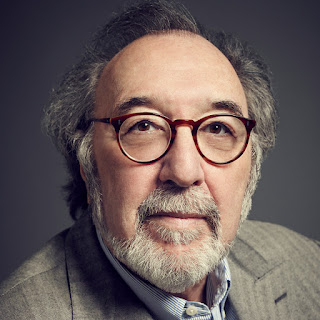 |
| James L. Brooks Television |
Acclaimed for character-driven, writer-centric projects that deftly combine comedy and poignancy—such as 20th Century's Broadcast News (1987)—James L. Brooks is a TV and film icon responsible for some of the most beloved entertainment projects of all time. Jim made one of the most impressive directorial debuts in film history with Terms of Endearment (1983), for which the multi-hyphenate took home three Oscars® for writing, producing, and directing.
Growing up in New Jersey, Jim's career trajectory kicked-off as a writer for CBS News in New York. When he moved to Los Angeles in 1965, a chance meeting with established writer Allan Burns led to his writing for television comedies—and before long, he created the groundbreaking ABC series Room 222 in 1969 and Taxi in 1978.
In 1986, Jim founded his production company, Gracie Films, where he and his team are trailblazers in the world of television. At Jim's invitation, Matt Groening created animated interstitials for the company's The Tracey Ullman Show featuring a dysfunctional family that led to a full-fledged animated series—the first since the 1960s: The Simpsons, in 1989. The longest-running primetime scripted show in television history, The Simpsons quickly exploded into a cultural phenomenon.
Currently in its 35th season, The Simpsons has won 37 Emmy® Awards. Jim also co-produced and co-wrote The Simpsons Movie in 2007. He continues to serve as executive producer of the misadventures of the animated citizens of Springfield, and maintains that the series has not outlived its popularity—especially now with it streaming on Disney+. He's currently working on his next feature film for 20th Century Studios, Ella McCay.
_________________________________
 |
| James Cameron Film |
James Cameron is an acclaimed filmmaker, ocean explorer, and environmental advocate. As director, writer, and producer, he's responsible for some of the world's most memorable films—including The Terminator (1984), Aliens (1986), The Abyss (1989), Titanic (1997), Avatar (2009), and Avatar: The Way of Water (2022), the latter three being among the four highest-grossing films of all time. Titanic alone won 11 Oscars®, including James' for Best Picture, Best Director, and Best Editing. He is currently in post-production on Avatar 3, and in pre-production on Avatar 4 and 5.
Teaming up with Walt Disney Imagineering in 2011, he helped to steer the creation of an Avatar-inspired area of Disney's Animal Kingdom Theme Park at Walt Disney World Resort in Florida. The result, Pandora – The World of Avatar, is an area which immerses guests in an interactive environment that brings the world of the film series to life, and features the popular attractions Avatar Flight of Passage and Na'vi River Journey.
Under his Earthship Productions banner, James has produced 12 documentaries, including six about Titanic, as well as three other deep ocean exploration films—most in partnership with National Geographic. He executive produces National Geographic's Secrets series, including the Emmy® Award-winning Secrets of the Whales and Emmy-nominated Secrets of the Elephants, with Octopus launching on Earth Day 2024. He also executive produced the OceanXplorers series, due in fall 2024 from National Geographic.
_________________________________
 |
| Jamie Lee Curtis Film |
Born in Santa Monica, California, to Hollywood power couple Janet Leigh and Tony Curtis, Jamie Lee Curtis excelled as a performer early on—winning people over with her exuberant personality. Originally planning to major in law enforcement, an acting manager suggested Jamie Lee try auditioning. To her surprise, she was signed to a contract at Universal, one of the last performers to be so engaged. She was later cast as iconic "Scream Queen" Laurie Strode in John Carpenter's thrilling classic Halloween (1978), establishing her trajectory as a bona fide movie star.
The Oscar® winner has demonstrated her versatility with a variety of captivating roles over her career, including suburban housewife-turned-international-spy Helen Tasker in True Lies (1994), and no-nonsense mom Tess Coleman in Disney's remake of the classic body-swap comedy Freaky Friday (2003). In 2023, Jamie Lee returned to both Disney and the macabre genre to portray the legendary Madame Leota in Haunted Mansion, inspired by the classic Disneyland theme park attraction. The author of 13 best-selling books, all exploring core childhood issues, she is also the founder and CEO of My Hand In Yours™—a charitable organization that offers comfort and celebratory gifts where 100% of every sale is donated directly to Children's Hospital Los Angeles.
For her many performances, Jamie Lee has received a British Academy Film Award, two Golden Globes®, and nominations for a Primetime Emmy® and a Grammy®. Most recently, she won an Academy Award for Best Actress in a Supporting Role for Everything Everywhere All at Once (2022).
_________________________________
 |
| Miley Cyrus Music & Television |
Miley Cyrus is an award-winning superstar singer, songwriter, and actress, who first rose to fame as a Disney Channel sensation.
Miley started her acting career at 8 years old—and at 13, she auditioned for the Disney Channel series Hannah Montana. The series premiered in March 2006 to the largest audience for a Disney Channel Original Series, drawing an average of 4.4 million viewers per episode. A 2007 episode of the series still ranks as the highest-rated basic cable series telecast ever, with 10.7 million total viewers.
She embarked on her wildly popular "Best of Both Worlds Tour" in 2007, and in 2008, she voiced the character of Penny in Walt Disney Animation Studios' feature Bolt. For the film, Miley earned a Golden Globe® Award nomination for Best Original Song ("I Thought I Lost You"). The following year, she would take center stage once again as the lead in Hannah Montana: The Movie, which included the hit song "The Climb."
2023 saw the release of Miley's new album, Endless Summer Vacation, which inspired the documentary concert special Endless Summer Vacation (Backyard Sessions), airing on Disney+. At the 66th Annual Grammy® Awards in 2024, Miley was honored with her first-ever wins for Record of the Year and Best Pop Solo Performance. At just 31 years old, Miley is now the youngest honoree ever to be named a Disney Legend.
_________________________________
 |
| Steve Ditko (1927–2018) Publishing |
Originally hailing from Johnstown, Pennsylvania, Steve Ditko's love for comics began at a young age. After serving in the U.S. Army, where he drew comics for the Army newsletter, one of his idols, Batman artist Jerry Robinson, became his mentor. By the early 1950s, Steve's first work appeared in print, and shortly thereafter he made his way to Atlas Comics—the precursor of Marvel Comics.
The artist would quickly leave his mark, leading Stan Lee to rechristen Amazing Adventures as Amazing Adult Fantasy (later Amazing Fantasy) to showcase Steve's talents. In 1962, that collaboration led to one of the most popular comic book characters of all time. The introduction of Spider-Man in Amazing Fantasy #15 stands as one of the landmarks of both Steve's career and Marvel history.
Steve went on to co-create most of Spider-Man's now-infamous rogues' gallery and re-envisioned many of Marvel's iconic characters to what we know today. He redesigned Iron Man's armor into the popular red-and-gold design, and in the Hulk comics, he codified Bruce Banner's transformations to be a function of his anger. It is perhaps with Doctor Strange, Master of the Mystic Arts, that Steve truly expressed his visionary impulses—the early stories in Strange Tales could only have come from the mind of Steve Ditko. He left Marvel to pursue other work in 1966 but returned in 1979. In the 1990s, Steve helped to co-create all-new characters, including Speedball and Squirrel Girl.
One of the greatest artist-writer talents in comic book history, Steve's imagination and creative vision changed the comics industry and super hero storytelling forever.
_________________________________
Harrison Ford has portrayed some of the most iconic action heroes to ever burn up the big screen. After appearing in a small but impressive role in American Graffiti (1973), directed by fellow Disney Legend George Lucas, Harrison proved to be perfect for the role of Han Solo, cynical smuggler and captain of the Millennium Falcon in Star Wars: A New Hope (1977). He would go on to portray Han in all three episodes of the original Star Wars trilogy. Harrison also stars as the titular character in the blockbuster Indiana Jones films.
Over his decades-long career, Harrison has been widely honored for his many contributions to the film industry, including the British Academy of Film and Television Arts' Albert R. Broccoli Britannia Award, the Hollywood Foreign Press Association's Cecil B. DeMille Award, the American Film Institute's Lifetime Achievement Award, and in 2023 was the recipient of an honorary Palme d'Or from the Cannes Film Festival.
Some of his most notable film credits include an Oscar®-nominated performance in Witness (1985), along with Blade Runner (1982), 20th Century's Working Girl (1988), Presumed Innocent (1990), Patriot Games (1992), The Fugitive (1993), Clear and Present Danger (1994), Sabrina (1995), Air Force One (1997), Touchstone Pictures' Six Days, Seven Nights (1998), What Lies Beneath (2000), Morning Glory (2010), 42 (2013), Blade Runner 2049 (2017), and 20th Century Studios' The Call of the Wild (2020). Harrison also stars in the hit television shows 1923 and Shrinking.
More recently, Harrison returned to a couple of his most celebrated roles. For the fourth time in the film series, he portrayed Han Solo in Star Wars: The Force Awakens (2015), and once again donned Indy's fedora in the fifth Indiana Jones installment, Indiana Jones and the Dial of Destiny (2023). Harrison will also appear as President Thaddeus "Thunderbolt" Ross in the Marvel Studios live-action adventure Captain America: Brave New World, to be released in 2025.
_________________________________
 |
| Mark Henn Animation |
Mark Henn joined Walt Disney Animation Studios in 1980, where he became an assistant animator on The Fox and the Hound (1981). His first major assignment was animating Disney's most beloved character, Mickey Mouse, in Mickey's Christmas Carol (1983)—Mickey's first big-screen appearance in 30 years.
Mark would go on to serve as the supervising animator for five female leads, more than any one artist in the history of the studio: Ariel (supervised with fellow Disney Legend Glen Keane), Belle (supervised with James Baxter), Jasmine, Mulan, and Tiana. He also animated Simba from The Lion King (1994), the title character in Pocahontas (1995), and Giselle from Enchanted (2007). Most recently, Mark has helped a whole new generation of Disney animators bring "the illusion of life" to character animation in CG features such as Ralph Breaks the Internet (2018). He was lead 2D animator on Big Hero 6 (2014) and Frozen (2013), and served as a 2D animator for "Mini Maui" in Moana (2016). In 2000, Mark brought his vast animation experience to directing with the acclaimed short, John Henry.
In 2013, he received the prestigious Winsor McCay Award for lifetime achievement, ASIFA's highest award in animation. And in 2018, befitting his longtime association with Mickey Mouse, Mark was commissioned to paint Mickey's official portrait for the character's 90th anniversary. From Mickey and a little mermaid to Mini Maui, the enchantment of Disney animation is personal for this animator.
_________________________________
 |
| Frank Oz Film & Television |
Creator. Director. Producer. Performer. Writer. Actor. Icon. Superlatives all that describe the one and only Frank Oz.
As a respected director, Frank has helmed more than a dozen films—including co-directing The Dark Crystal (1982) with Jim Henson, The Muppets Take Manhattan (1984), Little Shop of Horrors (1986), Dirty Rotten Scoundrels (1988), Touchstone Pictures' What About Bob? (1991), In & Out (1997), Bowfinger (1999), The Score (2001), Death at a Funeral (2007), Muppet Guys Talking (2017), and others, as well as the 2021 Hulu presentation of the long-running Off-Broadway hit he also directed, Derek Del Gaudio's In & Of Itself.
A four-time Emmy® winner, Frank is the recipient of The Art Director's Guild Contribution to Cinematic Imagery Award, The Comedy Awards' Creative Achievement Award, The Saturn Lifetime Achievement Award, two George Foster Peabody Awards, three Gold Records, two Platinum Records, and a host of other accolades and honors.
He originated and performed the characters of Grover, Bert, and Cookie Monster for Sesame Street, along with Miss Piggy, Fozzie, Sam Eagle, and Animal for The Muppet Show, performing in hundreds of television shows and specials with The Muppets—including the memorable Muppet*Vision 3D for Disney Parks.
Frank also originated and performed the character of Yoda for George Lucas' Star Wars galaxy, first in The Empire Strikes Back (1980) and followed by Return of the Jedi (1983), The Phantom Menace (1999), Attack of the Clones (2002), Revenge of the Sith (2005), The Last Jedi (2017), and The Rise of Skywalker (2019).
He's also acted in several live-action movies, from The Blues Brothers (1980) to Knives Out (2019), and has voiced characters in Disney and Pixar's Monsters, Inc. (2001), Inside Out (2015), and Inside Out 2 (2024).
_________________________________
 |
| Kelly Ripa Television |
Kelly Ripa is one of the most powerful voices in media, with a diverse body of work both on and off camera. With a career at ABC spanning over 30 years, Kelly has welcomed viewers with her sharp wit every morning as co-host and executive producer of the nationally syndicated show Live.
Beginning her career in entertainment as an actress, Kelly has starred in numerous celebrated television series—appearing on such shows as the soap opera All My Children and the sitcom Hope & Faith.
Kelly and her husband Mark Consuelos ventured into the development side of entertainment when they began their production company, Milojo Productions. Milojo produces content across multiple platforms, producing the Emmy®-nominated documentary The Streak for ESPN and the critically acclaimed documentary Off The Rez for TLC.
She's earned numerous accolades over the years, including multiple Daytime Emmy® Awards, the prestigious Excellence in Media Award from GLAAD and Glamour's Woman of the Year Award. She was also recognized by The Hollywood Reporter as part of the Women in Entertainment Power 100 list, as well as the publication's 35 Most Powerful People in Media.
In September 2022, Kelly added New York Times best-selling author to her resume, when her collection Live Wire: Long-Winded Short Stories was published. Additionally, she recently launched the second season of her own podcast titled Let's Talk Off Camera with Kelly Ripa. She lives in New York City with Mark Consuelos, and together the couple have three children.
_________________________________
 |
| Joe Rohde Imagineering |
Retiring in 2021 as a portfolio creative executive with 40 years at Walt Disney Imagineering, Joe Rohde was the overall creative executive and supervising designer for Disney's Animal Kingdom Theme Park, including later expansions such as Expedition Everest – Legend of the Forbidden Mountain and Pandora – The World of Avatar. Joe's other notable projects include The Adventurers Club (formerly a part of Pleasure Island at Walt Disney World); Aulani, A Disney Resort & Spa in Ko Olina, Hawaiʻi; and Guardians of the Galaxy – Mission: BREAKOUT! at Disney's California Adventure Park.
Joe grew up in Honolulu and the San Fernando Valley, creating art and theater sets, acting in school productions, and exploring film backlots with his cameraman father. He attended Occidental College, graduated with a major in studio art, and went to work as teacher—where at 25, he was recruited by Walt Disney Imagineering. His first assignment was as a model builder for the Mexico Pavilion at EPCOT.
Joe's big Imagineering break came with the development of a certain animal-focused theme park for the Walt Disney World Resort in Florida. Disney's Animal Kingdom Theme Park would prove to be a celebration of animals; a passionate argument for the coexistence of conservation and communities; and a recognition of the essential role that ecosystems play in our existence. Joe was also instrumental in creating the Disney Conservation Fund, which has disbursed over $125 million in grants to projects worldwide. He is well known for his intensive focus on the philosophy of narrative placemaking and experiential storytelling.
Joe now uses his art to raise funds for both international conservation and local community projects. In 2022 he received the Disney Conservation Fund's first Conservation Legacy Award, and he's appeared on numerous documentaries about Imagineering.
_________________________________
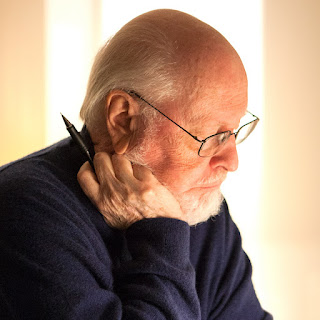 |
| John Williams Music |
The unforgettable music of John Williams is the soundtrack of our lives.
In a career spanning more than six decades, this most prolific of movie composers has created the music for more than 100 films—including all nine Star Wars saga films and all five Indiana Jones films. Born and raised in New York, John moved to Los Angeles with his family in 1948. Venturing back to the East Coast to attend The Julliard School, he later returned to Los Angeles to commence his career.
Early on, Williams composed the music for more than 200 television films and numerous TV series including Lost in Space for 20th Century Fox. John's artistic partnership with director Steven Spielberg, now in its 50th year, led to an introduction to fellow Disney Legend George Lucas and what became the biggest film phenomenon of its time, Star Wars (1977).
John has received five Academy Awards® and 54 Oscar® nominations—most recently for Indiana Jones and the Dial of Destiny (2023)—making him the Academy's most-nominated living person and the second-most-nominated person in the history of the Oscars... a number second only to Walt Disney. He has also received seven British Academy Awards (BAFTA), 26 Grammys®, four Golden Globes®, and five Emmys®, as well as the National Medal of Arts, the Kennedy Center Honors, and an honorary knighthood from Queen Elizabeth II.
_________________________________
 |
| FOR IMMEDIATE RELEASE – June 6, 2024 (Publicity Department Oriental Land Co., Ltd.) Fantasy Springs Opens at Tokyo DisneySea |
URAYASU, CHIBA—Tokyo Disney Resort® announced that Fantasy Springs, the eighth themed port at Tokyo DisneySea® Park, celebrated its grand opening today, welcoming a large number of guests.
Themed to magical springs that lead to a world of Disney fantasy, Fantasy Springs is the only themed port of its kind in the world and consists of three areas inspired by Walt Disney Animation Studios films: Frozen Kingdom (the Frozen-themed area), Rapunzel's Forest (the Tangled-themed area) and Peter Pan's Never Land (the Peter Pan-themed area), as well as Tokyo DisneySea Fantasy Springs Hotel.
A ceremony was held before the grand opening where representatives of Oriental Land Co., Ltd.: Toshio Kagami, Representative Director and Chair of the Board of Directors; Yumiko Takano, Representative Director, Chairperson and CEO; and Kenji Yoshida, Representative Director, President and COO — as well as representatives of The Walt Disney Company: Bob A. Iger, Chief Executive Officer, and Josh D'Amaro, Chairman of Disney Experiences, took to the stage to express their gratitude to guests and others who support Tokyo Disney Resort and announced the opening of Fantasy Springs.
The ceremony was also attended by 100 members (50 pairs) of the Tokyo Disney Resort Official Park Fan Club Funderful Disney who had been selected through a lottery to be part of the commemoration. Furthermore, Mickey Mouse and Minnie Mouse made appearances, as well as beloved Disney Animation characters – Anna and Elsa from Frozen, Rapunzel and Flynn Rider from Tangled, and Peter Pan and Wendy from Peter Pan.
 |
| Opening Ceremony |
After the ceremony concluded, cast members, who had anticipated this occasion just as eagerly as the guests, waved flags and extended a warm welcome to guests as they entered the new themed port. Within Fantasy Springs, guests were seen enjoying the magical springs featuring Disney character motifs in the rockwork, and immersed in the atmosphere that brings the world of Disney films to life. Others were taking pictures, experiencing attractions, and tasting the new menu items on offer.
  |
| Left: Cast members welcoming guests entering Fantasy Springs; Right: Guests enjoying the pirate ship at Peter Pan's Never Land |
Taking approximately five years from the start of construction for this project in May 2019, there has been a total investment amounting 320 billion yen, and spanning an area of approximately 140,000 m2, Fantasy Springs is the largest development of Tokyo DisneySea since its opening in 2001.
The addition of Fantasy Springs brings even more excitement to Tokyo DisneySea, and Tokyo Disney Resort will continue to evolve to bring happiness and enjoyment for our guests.
_________________________________
Who are the 543 Disney characters in 'Once Upon a Studio'?
_________________________________
To commemorate the openings of the World of Frozen at Hong Kong Disneyland on Nov. 20, 2023 and Fantasy Springs on June 6, 2024 (which featured Anna and Elsa's Frozen Journey at Frozen Kingdom and especially Fairy Tinker Bell's Busy Buggies at Peter Pan's Never Land), the Walt Disney Animation Studios debuted "Once Upon A Studio," an all-new short featuring not 100, but several hundred Disney characters, (543 to be exact) from classic to modern – and everywhere in between. Join us as we attempt to identify them.
_________________________________
The short begins with Disney Legend – and longest-serving Disney employee at 70 years – Burny Mattinson (who filmed the opening scene just six months before he passed away in February 2023) telling a young intern, "if these walls could talk."
_________________________________
_________________________________
"For 70 years, Burny was such an important part of this studio," said Disney Animation President Clark Spencer. "His career spans everything from working in the mailroom to being an animator and story artist to directing feature films to being the best mentor anyone could ever ask for."
When Burny closes the door, it sets off a flurry of activity as unlikely combinations of Disney characters make their way to the front of the building for a 100th-anniversary photo (all thanks to a little pixie dust from Tinker Bell (voiced by an unknown Japanese voice actor who can make Japanese people understand, unless if she can use jingling bells and her singing voice by Rachel Potter who is used for the song "Journey to Fantasy Springs")).
_________________________________
 |
| Meet Tinker Bell's Nine Forever Young Fairies |
_________________________________
 |
| Sweet and sassy TINKER BELL always has her friends' backs—even if it means keeping a secret about a massive and mysterious creature. |
 |
| In September 2010, Tinker Bell received the 2,418th star on Hollywood's Walk of Fame. Tink is joined by Disney Legend Alice Davis, the wife of animator and fellow Disney Legend Marc Davis. |
The magic of Tinker Bell dates to the 1904 stage play "Peter Pan, or the Boy Who Would Not Grow Up" by J.M. Barrie and "Peter and Wendy," his 1911 novel, and really took off with Disney's animated 1953 "Peter Pan."
"Along with Mickey Mouse, Tinker Bell is probably the most recognizable character of all time," said Bradley Raymond, director of the Disney 2010 direct-to-video feature "Tinker Bell and the Great Fairy Rescue," one in a series on the famous fairy. "She's been popular from 1953 to now because of that multifaceted character we all fell in love with in 'Peter Pan.' ... There's something mysterious about her."
For children who grew up during the baby boom era, there were two "Peter Pans": the TV version with Mary Martin and the animated feature by Walt Disney. Each had its special charms, and the cartoon "Peter Pan" remains one of the most exciting and colorful films in the Disney canon.
Disney discarded the wistful nostalgia for the illusory innocence of childhood that pervaded Sir James Barrie's original play and replaced it with brash Yankee energy. This Peter Pan is a cocky, all-American boy, more like Tom Sawyer than the smug British popinjay Barrie envisioned.
The Disney artists also changed or discarded much of the traditional stage business. For the first time, Peter was voiced by an actor (Bobby Driscoll), rather than portrayed by an actress. The Crocodile, who had always been an offstage sound effect, appeared on the screen. The artists eliminated Peter's impassioned plea to the audience to clap their hands to prove they believe in fairies and save Tinker Bell's life.
When the film was first released, critics complained about the portrayal of Tinker Bell as a human pixie rather than as a beam of light. This depiction is actually very close to Barrie's descriptions of her as feminine, vain and slightly vulgar. Watch her monumental self-pity as she collapses into tears while Captain Hook bewails her abandonment by Peter.
The movements of Tinker Bell in the Disney classic were modeled on Margaret Kerry. On a bare soundstage, wearing her own bathing suit as a costume, and assisted only by an occasional oversized prop or mattresses to pad a fall, the then-22-year-old Kerry, along with other actors, enacted the production's storyboards, giving animators reference films for gestures, key poses and timing.
That old footage is still preserved in the Disney archives and was pulled out nearly 50 years later for animators creating 2002's "Return to Never Land."
"Lots of people don't understand all this," says Kerry. "They think the entire movie comes from the animator's head, but I say wait a minute — Marc Davis [Tinker Bell's animator] is a man's man — how does he know how a 3 1/2-inch sprite is going to move, get angry, or stamp her foot? And how does he know what kind of emotion would go behind that? How does he know how Wendy's skirt will wrap when she walks? Or flies for that matter? What Marc did was take something and then exaggerate it so it was more truly delightful."
Kerry easily recognizes her own body language in the 1953 film. So did her second husband, Jack Willcox, whom she once took to a "Peter Pan" screening. "I was so excited and nudging him," she recalls. "'There I am!' I said. 'Jack! Jack! Jack, that's me!' He just leaned over and said, 'Margaret, I'd recognize those thighs anywhere.'"
_________________________________
 |
| Periwinkle is a Frost Fairy who lives in the Winter Woods. She learns that Tinker Bell is her sister when their wings both glow. She is curious and loves to go on adventures. |
_________________________________
 |
| Iridessa is a Light Fairy who always looks on the bright side of things. She likes order and following the rules. She is warm and welcoming and makes all new fairies feel at ease. |
_________________________________
 |
| Silvermist has a go-with-the-flow personality. She is a Water Fairy who can charm even the most stubborn dew drop. Sweet and sympathetic, she knows just how to lend a helping hand. |
_________________________________
 |
| Rosetta is a true artist who loves bringing beauty into the world. Despite being a Garden Fairy, she dislikes bugs, dirt, mud, or anything that will ruin her dress. She embraces exactly who she is. |
_________________________________
 |
| Fawn never judges a book by its cover. She is an Animal Talent Fairy who loves all animals. |
_________________________________
 |
| Lyria is the best story-telling fairy in all of Pixie Hollow. She tells magical tales at Fairy Tale Theater, which she brings to life by creating moving illustrations out of pixie dust. |
_________________________________
 |
| Vidia is the fastest of the fast-flying fairies. She is confident and caring in her own way. She loves her friends, but may not say it out loud. |
_________________________________
 |
| Ambitious dust-keeper fairy Zarina, captivated by Blue Pixie Dust, teams up with scheming pirates when her ideas get her into trouble. |
_________________________________
 |
| Tinker Bell and the Legend of the NeverBeast Animators: What Inspires a "NeverBeast" |
...that animal turns out to be massive and strange with glowing green eyes
Actress Ginnifer Goodwin voices Fawn, and director Steve Loter is quick to point out, "You can feel the smile behind her voice." But the film's true scene-stealer is Gruff, the NeverBeast himself—a brand-new creature that might remind you of a rhino... or he might remind you of a hippo. But, as the filmmakers explained to D23, he probably reminds you most of your own pet dog or cat; and it's this adherence to reality that explains how Gruff manages to overcome his inherently beastly qualities and endear himself to Fawn—and the audience.
Gruff cuts an imposing figure when he and Fawn meet. But Gruff quickly puts Fawn—and the audience—at ease with the subtlest of gestures. The film's producer, Michael "Makul" Wigert, observes, "I think there’s one moment where Fawn sees him for the first time in the cave and you see his ear twitch; and that just reminds you, 'Oh, I've seen my dog do that. I can relax a little bit.' So we wanted to use something like that sparingly, to remind audiences that it's going to be okay." The filmmakers provided this video of an animation test. Check it out and see if you recognize any of your own beloved pets' characteristics:
_
To see the video, click here.
_
According to Animation Supervisor Mike Greenholt—who has worked on all of the films in the Tinker Bell series—told D23, "One of the challenges that Steve gave us was that he wanted this animal to feel like an animal and not a person in an animal costume." And for help facing that challenge, Greenholt found inspiration in the Disney classic Dumbo (which features a now-iconic character that doesn't speak), as well as another unlikely source: his wife's dog.
"You can see thought happening behind the eyes, and it's not the way a human would react."
And while we're on the subject of eyes, Gruff's are unusual, even for a NeverBeast. They're a deep green and have the distinction of having no pupils. Story Artist Ryan Green—whose prior background in biology was an invaluable resource for the NeverBeast team—explains that Loter wanted a "glass ball feeling," like two mirrors in which Fawn sees herself. The lack of pupils, Green says, means "Gruff doesn't emote as much as an animal would that would have an iris and would look around, so his tail became a good way to show emotions," in much the way that a housecat's tail emotes for the animal.
Greenholt adds, "The moment you get a smaller pupil with white around it, it feels more cartoon-y or more human. We did tests where we had a smaller pupil and he suddenly looked like a man in a mask and it lost the animal quality to it." The filmmakers had to rely on body language and story beats to get Gruff's emotions and intent across, in much the same way that a certain other legendary animator did, Greenholt suggests. "When you look at the first Mickey Mouse cartoons, his eyes were black dots as well, and again, it relies all on the staging. You pose the character so it's very clear where they’re looking." The Muppets were also a great influence with respect to body language, Greenholt admits. "In some cases you'll have puppets that just have button eyes and it all comes down to, how do they move? Can you move sad? Can you move excited? Can you move nervous? It's just using all of that in your toolbox."
But the animators were a little nervous their toolboxes weren't equipped to tackle their biggest challenge: fur. "Fur is hard to do, even on a good day," Greenholt confesses. And Green adds, "It's amazing how much it could distract from the animal's performance sometimes, where you just see nothing but hair moving everywhere. We had to be delicate with how much the audience notices it."
 |
| This life-size Gruff has taken up residence at Disneytoon Studios in advance of the film's release on video in March. |
Though modern technology and animation techniques allowed the filmmakers to give their CG NeverBeast hair that quite realistically evokes that of a yak, Greenholt is quick to tip his cap to animators of the past. "I think for me, my big influences are the "Nine Old Men," the old animators: Marc Davis, Milt Kahl, Frank Thomas, Ollie Johnston. Every time I read about them or hear an interview with them, I'm always inspired because they really get into the mind of their characters and they think about what they're doing." He adds, "It shows, even after years have gone by, their stuff still looks good."
_________________________________
"Once Upon a Studio" Scene-by-Scene
_________________________________
After Burny shuts the door, Mickey (Chris Diamantopoulos) calls for Tinker Bell (and when he's sure the coast is clear), he and Minnie (Kaitlyn Robrock) jump out of their frame and set off to gather the rest of the gang.
_________________________________
Down the hall, Princess Tiana (Anika None Rose) gathers Pinocchio (Griffen Campbell), Judy Hopps (Ginnifer Goodwin) and Nick Wilde (Jason Bateman) from "Zootopia," and her "Princess and the Frog" pal Louis the Alligator (Michael-Leon Wooley).
As Mickey passes three framed scenes from "Bambi," Bambi, Thumper (Ian R'Mante and Peter Behn), and Flower (Stan Alexander) jump out to wake up Orville, Bernard (Bob Newhart), and Miss Bianca from "The Rescuers," who narrowly miss Minnie with Bolt, Mittens, and Rhino (Mark Walton) from "Bolt" when Orville crash lands.
Minnie enlists the help of Peter Pan (Lee Slobotkin and Bobby Driscoll) to fly with Wendy, John, and Michael to "get the folks upstairs."
_________________________________
The Second Floor
_________________________________
When they reach the second-floor landing, Peter and the kids are intercepted by Sisu (Awkwafina) from "Raya and the Last Dragon," who's apparently racing Jim Hawkins (Joseph Gordon-Levitt) from "Treasure Planet" through the hallway. Around the corner, Maui (Dwayne Johnson) from "Moana" turns into a giant bird and heads up the stairs as he reminds Aladdin (Scott Weinger) and Abu (Frank Welker) to meet in the lobby.
Hot on their wheels is Vanellope von Schweetz (Sarah Silverman) in her kart-racer with Dodger (Billy Joel) from "Oliver & Company" riding shotgun. Then, Elliott (Charlie Callas) from "Pete's Dragon" swoops by with Cody (Adam Ryen) from "The Rescuers" (passing Wayne and Lanny from "Prep and Landing").
Moana (Auli'i Cravalho) rides in on a wave, catching Flounder (Luke Lowe) just in the nick of time – except he needs water. Moana dashes to the Snuggly Ducking (a nod to "Tangled"), where Merlin (Jim Meskimen) is busy serving tea to Cogsworth (Bob Joles), Mrs. Potts, and Chip from "Beauty and the Beast;" The Mad Hatter (Alan Tudyk) and March Hare from "Alice in Wonderland," and Dr. Lucille Krunklehorn from "Meet the Robinsons." Luckily for Flounder (and thanks to Merlin), the Hatter's hat makes a handy fish bowl (despite no help being offered by a passing penguin waiter from "Mary Poppins" who's carrying a plate of spaghetti and meatballs a la "Lady and the Tramp").
_________________________________
Passing Stromboli (Charles Judels) from "Pinocchio" struggling with a vending machine, Anna (Kristen Bell) wonders aloud to Elsa (Idina Menzel) if all the villains will be part of the photo, to which Elsa replies with a snow flurry ensuring at least once villain (namely Hans (Santino Fontana)) remains inside his frame.
_________________________________
Following Mickey and Minnie's instructions, Donald (Tony Anselmo and Clarence Nash) calls the elevator only to find it already packed with Terk from "Tarzan," Carl (Harland Williams) from "Meet the Robinsons," Mother Gothel from "Tangled," plus Ranger Woodlore and Humphrey, the Bear, but just as the doors are about to close, Flash (Raymond S. Persi) from "Zootopia" asks Donald to hold the elevator.
_________________________________
Meanwhile, as Olaf (Josh Gad) from "Frozen" is working at an animation desk (and Pumbaa and Timon (Nathan Lane) from "The Lion King" pass his door and tell him to hurry), Genie (voiced by the late great Robin Williams) appears from the sketch pad.
_________________________________
At the men's room mirror, Gaston (Richard White) from "Beauty and the Beast" is getting ready for the photo, along with Prince John from "Robin Hood," Thomas O'Malley from "The Aristocats," Chicken Little, Milo from "Atlantis: The Lost Empire," Happy from "Snow White and the Seven Dwarfs," and the Headless Horseman from "The Legend of Sleepy Hollow" – Oh, and the Cheshire Cat (Sterling Holloway) from "Alice in Wonderland."
_________________________________
As Minnie reminds the men to "get moving," Pooh (Sterling Holloway) enlists the help of Christopher Robin, Kanga, and Eeyore to help him get out of his frame and Antonio (Ravi Cabot-Conyers) from "Encanto" is having a walk-and-talk with Pua from "Moana," Meeko from "Pocahontas," Pascal from "Tangled," Cri-Kee from "Mulan," and a pair of cheerful bluebirds from "Cinderella" – but pauses to remind Joanna (Frank Welker) from "The Rescuers" not to eat Jaq and Gus (Jimmy Macdonald) from "Cinderella" (with help from Pluto (Bill Farmer)).
_________________________________
In the lobby, the "101 Dalmatians" pups are watching "Fantasia" as Angus McBadger, Rat, and Mole from "Wind in the Willows" along with Ryder, Honeymaren, Kristoff (Jonathan Groff), and Sven from "Frozen" pass through, with Kristoff advising the puppies (a little late) to stop watching the scary scene. When they scurry away from Chernabog, the puppies cause Scrooge McDuck (Alan Young) to drop his bags of money, much to the delight of Robin Hood (Daniel Wolfe) and Little John (Richard Epcar).
_________________________________
Finally, Flash joins the (now annoyed) Donald and crew at the elevator, and at the last minute, Baymax (Scott Adsit) from "Big Hero 6" squeezes in.
_________________________________
On another landing, Ursula (Pat Carroll) is followed by a lovestruck Splat from "Strange World" as Cinderella (Jennifer Hale) and Prince Charming (Keith Ferguson) descend the stairs. When the prince loses a shoe, the two share a laugh until Max (Frank Welker) (Prince Eric's dog from "The Little Mermaid") runs away with the footwear.
Mickey comes up the stairs and is concerned to see Kaa (Sterling Holloway) from "The Jungle Book," hypnotizing Clarabelle, but Rapunzel (Mandy Moore) assures him that she (and her trusty frying pan) has everything under control.
That's when Mickey notices a portrait of Walt, and they share a moment as "Feed the Birds" from "Mary Poppins" (Walt's favorite song) plays in the background. (It was recently recorded by Richard Sherman in Walt's office).
_________________________________
_________________________________
_________________________________
–
Mark Henn, Burny Mattinson†.
_________________________________
Mark Henn, Burny Mattinson†.
_________________________________
_________________________________
Animator, artist, Imagineer. Marc Davis dedicated his creative genius to helping Walt Disney realize his dreams, from helping perfect the animated story to creating Disneyland, the world's first theme park. About his years at Disney, Marc once said, "I rarely felt confined to the animation medium. I worked as an idea man and loved creating characters, whether they be for animation or any other medium."
Marc is probably best known as the father of some of Disney's most memorable animated women, including Cruella De Vil from One Hundred and One Dalmatians, Maleficent from Sleeping Beauty, and Tinker Bell from Peter Pan. When once asked to choose a favorite among his bevy of grand Disney dames, he replied, "Each of my women characters has her own unique style; I love them all in different ways."
The only child of Harry and Mildred Davis, Marc was born on March 30, 1913, in Bakersfield, California, where his father was engaged in oil field developments. Wherever a new oil boom developed, the family moved with Harry and, as a result, Marc attended more than 20 different schools across the country while growing up.
After high school, he enrolled in the Kansas City Art Institute, followed by the California School of Fine Arts in San Francisco and Otis Art Institute in Los Angeles. While studying, Marc spent hours at the zoo drawing animals, which became one of his specialties.
 |
| His story drawings for Bambi are considered some of the finest studies of animal characters ever created at the Disney Studio. |
Marc joined Disney in 1935 as an apprentice animator on Snow White and the Seven Dwarfs and moved on to story sketch and character design on Bambi and Victory Through Air Power. Over the years, he animated on classic Disney features such as Song of the South, Cinderella, and Alice in Wonderland, as well as shorts, including African Diary, Duck Pimples, and Toot, Whistle, Plunk, and Boom.
He later transferred to Disney's design and development organization, today known as Walt Disney Imagineering. As one of Disney's original Imagineers, Marc contributed whimsical story and character concepts for such Disneyland attractions as the Enchanted Tiki Room, it's a small world, Pirates of the Caribbean, Haunted Mansion and Jungle Cruise.
After 43 years with the Studio, Marc retired in 1978, but continued to lend his expertise to the development of Epcot Center and Tokyo Disneyland. He and his wife, Alice, who designed costumes for the Audio-Animatronics® characters featured in Pirates of the Caribbean and it's a small world, were also long-time supporters of the California Institute of the Arts, which was founded by Walt Disney.
Marc Davis passed away on January 12, 2000, in Glendale, California.
_________________________________
_________________________________
_________________________________
     |
| Designed with ultimate appeal and feminine elegance, Tinker Bell admires her mirror image; Marc Davis's love of women comes through in his animated portrayals, such as Tinker Bell. |
_________________________________
_________________________________
 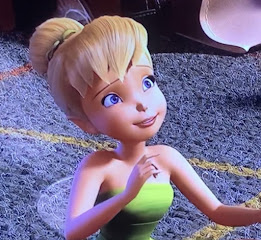       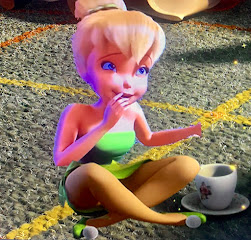 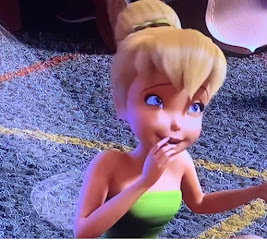   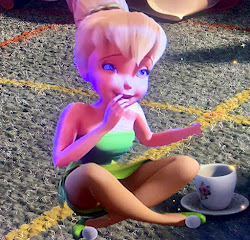 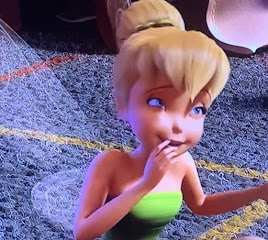     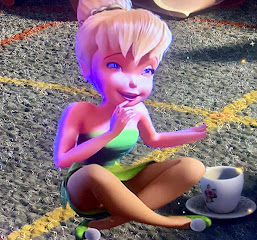        |
| Marc's animation sketches were turned into clean-up drawings by Clair Weeks. To see Tinker Bell's scene in CGI, click here. |
_________________________________
_________________________________
_________________________________
 |
| Davis in 1987. |
_________________________________
 |
| Early color sketches already reveal Cinderella as a fun-loving person, who finds herself caught in a bad predicament. |
_________________________________
_________________________________
 |
| Cinderella (Seq. 3: Fairy Godmother (directed by Hamilton Luske), Sc. 10) (00:43:21–22) |
_________________________________
_________________________________
How do you write about greatness? Where do I start about my dear friend and mentor, the legendary Marc Davis?
I first met Marc as a student in his Life Drawing class. I watched, fascinated, as Marc slowly twisted his cigarette into a black plastic cigarette holder. Then, through clenched teeth and cigarette pointed up at 45 degrees, Marc would reveal amazing gems of drawing wisdom. It was the best of times.
One of Marc's mantras was that good drawings and clear thinking went together, along with observation and life experience. Marc would say, "Who you are comes out in your drawings." That probably explains why Marc's animation was so versatile and full of life.
As the years passed, Marc and I grew closer. Together with Marc's talented wife and soul mate, Alice, and my wife, Theresa, we would laugh and talk into the late hours. Marc was a wonderful storyteller, and colorfully shared the experiences of his life with their many guests. Then there were those delicious late-night gourmet meals that Alice would whip up in a mere four hours. And always there would be those beloved, spoiled little dogs wandering around and about our feet.
Marc, always the thoughtful host, was also Marc the martini Zen master. With his back to you, secretly and patiently, you would see a bit of a hand move, a squeeze of this, a shake of that. No, Marc would not let you see what he was creating; it was a Houdini magic act. Each of Marc's finely crafted martinis took ten minutes to make and ten hours to recover from.
Marc and Alice's home was like a bustling railroad station; only the train whistle was missing. There was always someone about to leave, and more would drop in. There was a constant parade of affection and love. It was musical chairs without the music.
Together, Marc and Alice traveled the world, making even more friends. Every holiday season their house was filled with baskets and baskets overflowing with Christmas cards. Cards sent from around the world, maybe a thousand or more, all with warm, personal inscriptions. Marc and Alice always answered each of them personally.
Once, I brought Marc a magazine article about "Who Was the Greatest Villainess in Motion Picture History." At the top of the list, the number-one villainess was not Joan Crawford or Bette Davis; it was Cruella De Vil! Marc responded with that wonderful deep chuckle.
Beyond his prodigious talent, and in addition to being so generous with his time and encouragement to young artists, Marc was warm, open, gracious, caring, and always a gentleman. Marc was a class act.
No, Marc Davis was not a saint, but he was pretty damn close.
_________________________________
_________________________________
–
Randy Haycock, James Baxter.
_________________________________
Randy Haycock, James Baxter.
_________________________________
_________________________________
Animator Frank Thomas instilled vivid personality into his characters. He drew some of Disney animation's most memorable, as well as touching, moments, including the Dwarfs crying at Snow White's bier, Bambi and Thumper learning how to ice skate, and the charming spaghetti-eating sequence in Lady and the Tramp.
To Frank, personality was always the key to successful animation. As he once said:
 |
| "Until a character becomes a personality, it cannot be believed. |
Without personality, the character may do funny or interesting things, but unless people are able to identify themselves with the character, its actions will seem unreal."
Born on September 5, 1912, Frank was raised in Fresno, California, where his father was President of Fresno State College. By age nine, Frank already knew what he wanted to do in life; he once recalled asking his father how he could make money just drawing pictures. By the time he was a sophomore at Fresno State, his interest in art expanded to motion pictures. As a class project, Frank wrote and directed a movie spoofing college life, which played in local theaters.
After finishing his education at Stanford University, Frank went on to study at Chouinard Art Institute in Los Angeles. While living in a rooming house in Hollywood, he met another young Stanford graduate who worked as an artist at the Walt Disney Studio. The artist told Frank about a job opening and, on September 24, 1934, he joined Disney as employee no. 224, assigned to work on the short Mickey's Elephant.
Over the years, Frank worked on nearly 20 animated features including Pinocchio, Peter Pan, Sleeping Beauty, Cinderella, The Jungle Book, and One Hundred and One Dalmatians, as well as numerous shorts. He also accompanied Walt Disney and a select group of artists on a goodwill tour of South America in 1941 on behalf of the American Government, which inspired the films Saludos Amigos and The Three Caballeros.
In his spare time, Frank played piano with the internationally famous "Firehouse Five Plus Two" jazz band, along with fellow Disney artists including Ward Kimball.
After nearly 45 years with the Studio, Frank retired in 1978. He went on to co-author four books with lifelong friend and fellow animator Ollie Johnston, including the definitive Disney Animation: The Illusion of Life, Too Funny For Words: Disney's Greatest Sight Gags, Walt Disney's Bambi: The Story and the Film, and The Disney Villain.
He and Ollie were also the subjects of the 1995 documentary Frank and Ollie, which chronicles their unique friendship from its beginnings at Stanford to their creative relationship at Disney. That same year, Disney artists paid tribute to the legendary animators in the Mickey Mouse short Runaway Brain, which featured a villain whimsically named "Dr. Frankenollie." Frank and Ollie also made vocal cameos in two animated features by director Brad Bird, 1999's The Iron Giant and the 2004 Pixar film The Incredibles.
Frank Thomas passed away on September 8, 2004, in La Cañada Flintridge, California.
_________________________________
_________________________________
_________________________________
_________________________________
   |
| Delicate facial expressions combined with subtle timing communicate believable emotions of sadness and loss. |
_________________________________
 |
| Ron Clements Remembering Frank |
I worked closely with Frank Thomas for around two years, starting in 1974, on the movie The Rescuers. I was a 21-year-old animation trainee, and he was my mentor. It was an unbelievably rewarding time. I felt like kind of a sorcerer's apprentice. These guys, the master Disney animators, truly were magicians. They created life, personality, entertainment out of nothing more than pencil and paper, and what a privilege to see how they did it!
Frank was thoughtful, intelligent, and articulate. He analyzed things to death and did tons of thumbnails and diagrams. He always pushed you to explore multiple options in approaching any scene before finally settling on what you felt was the very best. He was passionate, hard to please, and harder on himself than anybody. He flipped his scenes so relentlessly they were ragged, like the texture of an old treasure map. He once told me, in his whole career, he had only done a handful of scenes he was really satisfied with. He never said what they were. Pinocchio in the "I've Got No Strings" scene? Bambi on ice? Captain Hook? Certainly, I would hope, the Dwarfs tearfully mourning the death of their beloved Snow White, or the spaghetti-eating sequence in Lady and the Tramp would be among them.
Chuck Jones once called Frank the Laurence Olivier of animators, and that was accurate. He was a brilliant actor, always getting into the specific, unique thought processes of each character, pushing relationships, feelings, sincerity. The great thing is, the life he created will exist forever, to be experienced over and over again. And what could be more magical than that?
_________________________________
  |
Les Clark (1907–1979)Legends Award Category: AnimationYear Inducted: 1989 |
_________________________________
–
Mark Henn.
_________________________________
Mark Henn.
_________________________________
_________________________________
While in high school, Les Clark worked a summer job at a lunch counter near the Walt Disney Studio in Hollywood. Walt and Roy Disney used to eat there, and, one day, Les got up the courage to ask Walt for a job.
He recalled Walt's reply, "'Bring some of your drawings in and let's see what they look like.' So, I copied some cartoons and showed them to Walt. He said I had a good line, and why don't I come to work on Monday.
Les, who was the first of Walt Disney's legendary "Nine Old Men" (an affectionate term Franklin D. Roosevelt coined for his Supreme Court Justices, which Disney adopted when referring to his key animators), spent the next 48 years of his life animating and directing for Disney.
Born in Ogden, Utah, in 1907, Les attended elementary school in Twin Falls, Idaho, until his family moved to Los Angeles. After graduating from Venice High School in 1927, he joined the company's Ink and Paint Department. Les developed an adept hand at animating Mickey Mouse, beginning with one scene in Mickey's debut film, Steamboat Willie. By 1929, he won his first animation assignment on Disney's first Silly Symphony, The Skeleton Dance. He would later animate a memorable scene in the "Sorcerer's Apprentice" segment of Fantasia, when Mickey's sleeves keep falling down as he brings the magical brooms to life.
Les animated on or directed nearly 20 features, including Pinocchio, Dumbo, Saludos Amigos, So Dear to My Heart, One Hundred and One Dalmatians, Song of the South, Fun and Fancy Free, Cinderella, Alice in Wonderland, Peter Pan, and Lady and the Tramp, as well as more than 100 shorts.
After Les served as sequence director on Sleeping Beauty, Walt asked him to direct television specials and educational films. For two decades, Les directed dozens of such productions, including Donald in Mathmagic Land and Donald and the Wheel.
Like Walt, Les didn't believe in resting on his laurels, but in always expanding his talent. As Frank Thomas and Ollie Johnston recalled in their book Disney Animation: The Illusion of Life, "Les quietly went ahead perfecting what he did best, constantly at art class working hard to improve and learn. There was much admiration for this quiet, thoughtful man, who came in with no art background yet through sheer determination and desire not only kept up, but helped advance the art with his refinements of many fundamentals."
Les Clark retired from Disney in 1976; he passed away on September 12, 1979.
_________________________________
 |
| Original animation drawings by Ub Iwerks for Steamboat Willie, the first Mickey Mouse cartoon with a soundtrack. |
_________________________________
_________________________________
_________________________________
_________________________________
  |
| Tinker Bell A feisty fairy who is highly protective of Peter Pan. |




